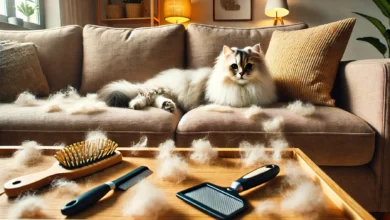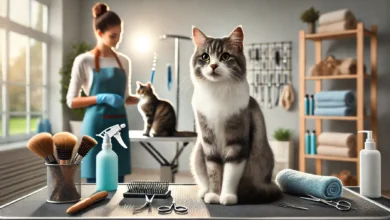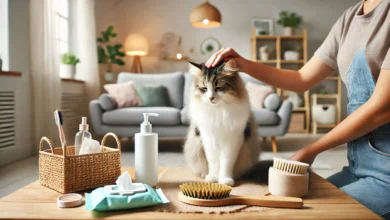How to Identify Skin Issues During Cat Grooming
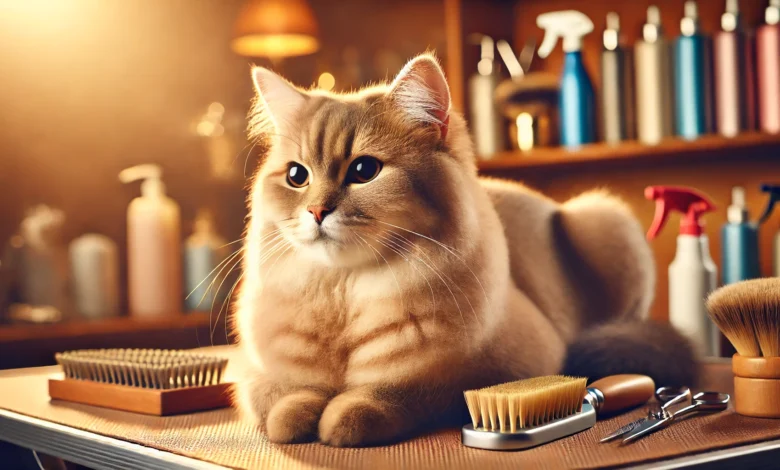
Grooming your cat is not only essential for keeping their fur clean and detangled, but it also provides a perfect opportunity to inspect your cat’s skin for potential issues that could affect their comfort or health.
Cats have thick fur coats that can sometimes mask signs of skin conditions.
During these grooming sessions, you may be able to identify skin problems early, allowing you to address them before they worsen.
In this guide, we’ll discuss the types of skin issues you may encounter with your cat, how to identify them, and ways to keep your feline’s skin healthy and comfortable.
Skin health is crucial for your cat’s well-being, yet it’s something that can be easily overlooked.
Have you noticed strange bumps, redness, or flaky patches on your cat’s skin during grooming?
These signs could indicate an underlying problem.
Knowing what to look for and how to address it can make all the difference.
Let’s start by identifying some common skin issues and how to recognize them.
Table of Contents
Common Skin Issues in Cats and How to Spot Them
When grooming, it’s essential to be on the lookout for specific signs that may indicate a skin problem.
Cats can experience a variety of skin issues, each with its unique symptoms.
Here are some common skin problems in cats and the signs you should be looking for to catch them early.
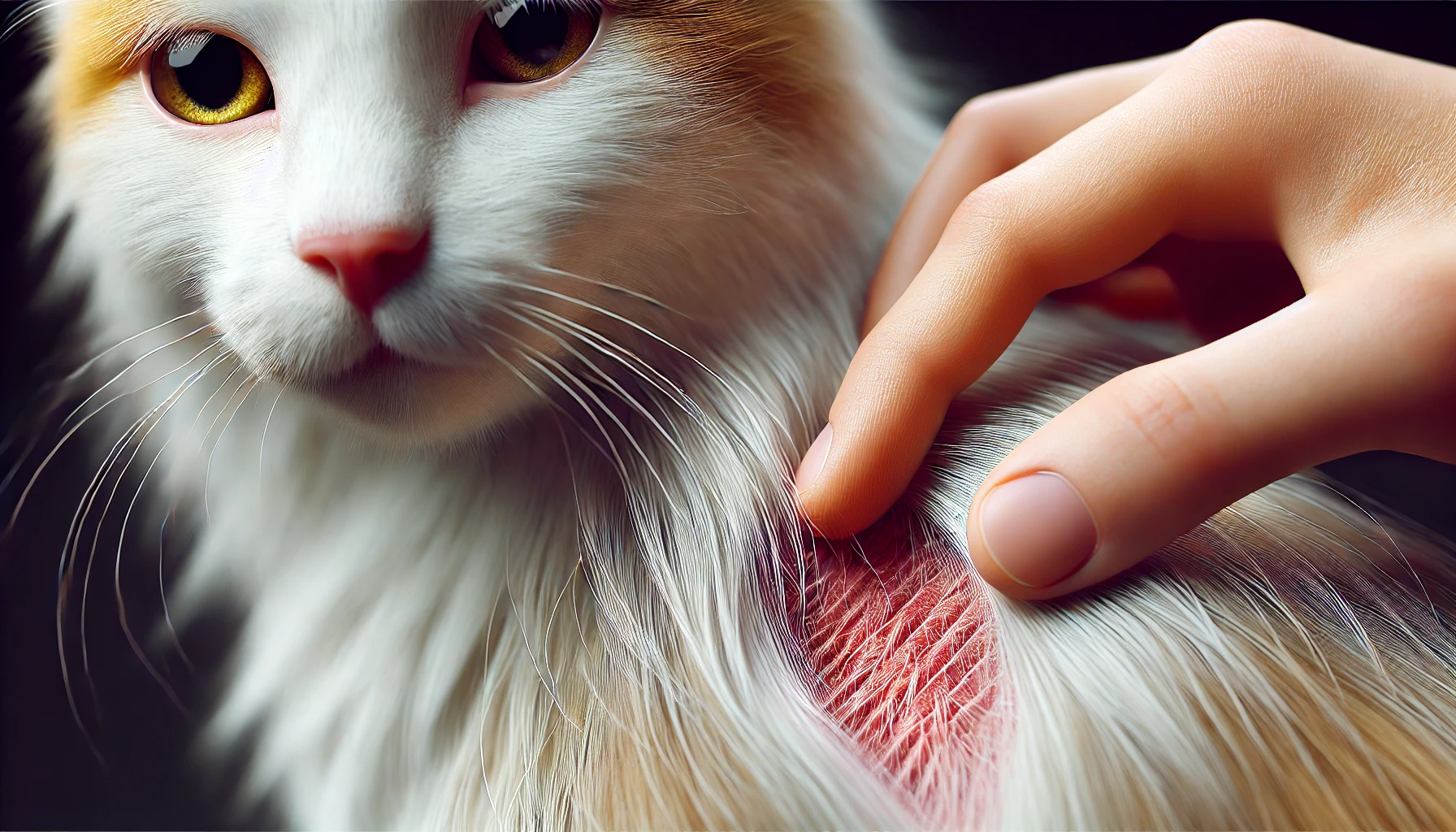
Redness, Bumps, and Inflammation
One of the early signs of skin problems in cats is redness, bumps, or areas of inflammation.
You may notice patches where the skin appears irritated or swollen.
These symptoms can be caused by allergies, infections, or reactions to grooming products.
During grooming, try parting your cat’s fur gently to check for red or swollen areas, especially if your cat reacts sensitively to touch in those spots.
- Red patches: These typically indicate irritation or mild inflammation, which can result from allergies or harsh grooming tools.
- Bumps: Small, raised bumps may be symptoms of flea bites or other insect bites, or even early signs of a bacterial infection.
- Inflamed skin: Look for areas where the skin appears thickened or swollen, which may signal an underlying skin issue.
If you notice any of these signs, document the affected areas and track any changes over time.
If these symptoms persist, it may be time to consult your veterinarian for a closer look.
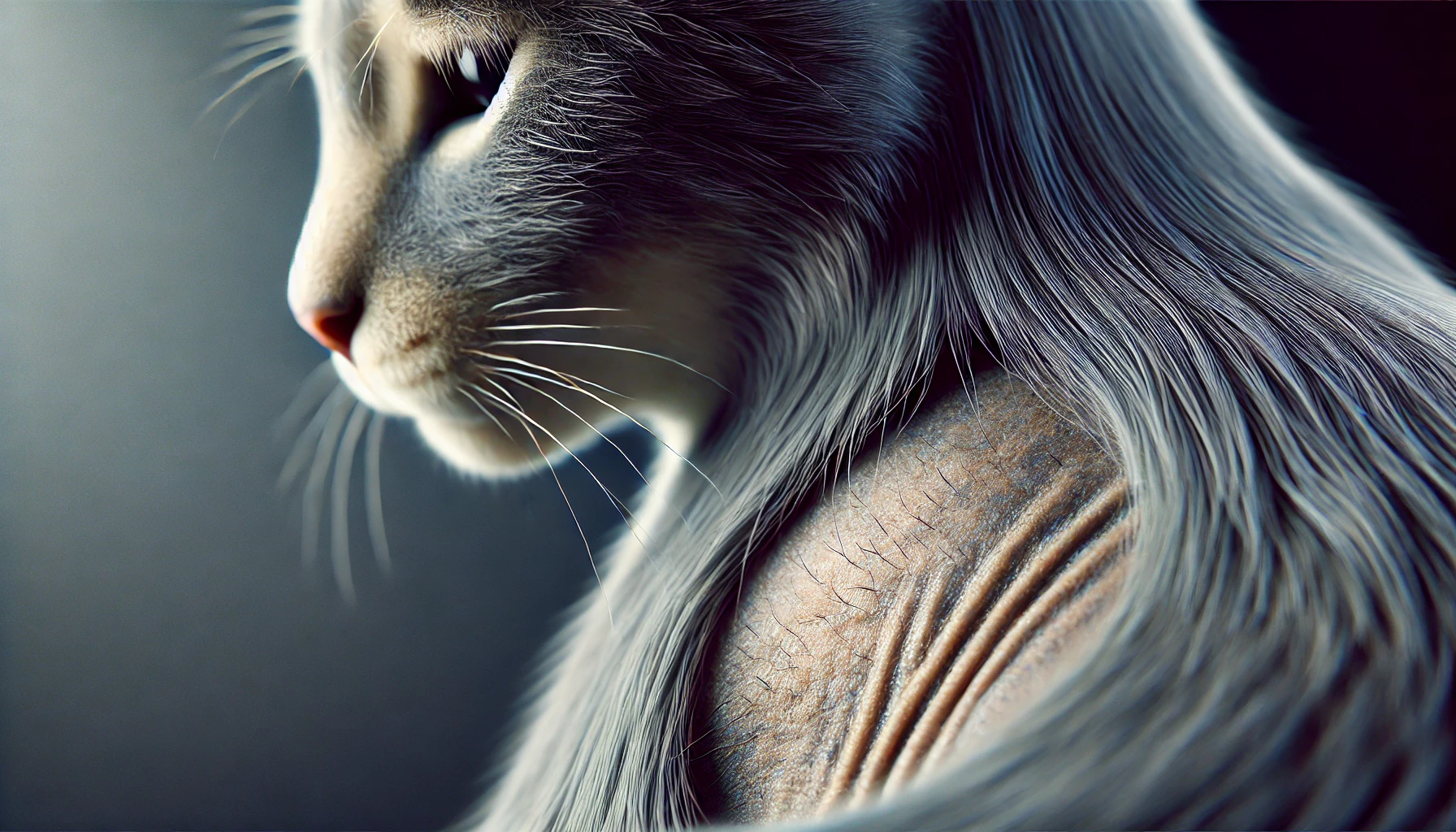
Hair Loss Patterns
Another sign of potential skin issues in cats is alopecia, or hair loss.
While some shedding is normal, excessive or patchy hair loss could indicate a deeper problem.
Cats experiencing hair loss may also groom specific areas excessively, which can exacerbate the issue.
During grooming, check for any areas with thin or missing fur, especially around the neck, belly, and base of the tail, where hair loss is more common.
- Patchy hair loss: This may indicate an allergy, a fungal infection such as ringworm, or even stress-related over-grooming.
- Symmetrical hair loss: Often related to hormonal imbalances or systemic health issues.
- Localized bald spots: These may be due to parasite bites or dermatitis, particularly if accompanied by redness.
The sooner you can identify abnormal hair loss, the better equipped you’ll be to address it before it worsens.
If you notice unusual patterns of hair loss in your cat, consult your vet to determine the cause and best course of treatment.
Spotting Skin Issues During Grooming
Look for redness, bumps, or inflammation while grooming, as these may indicate allergies, infections, or reactions to grooming products.
- Red patches often mean irritation or mild inflammation.
- Bumps may result from flea bites or bacterial infections.
- Inflamed skin may signify a deeper skin issue.
If you notice these signs, consult your vet if symptoms persist.
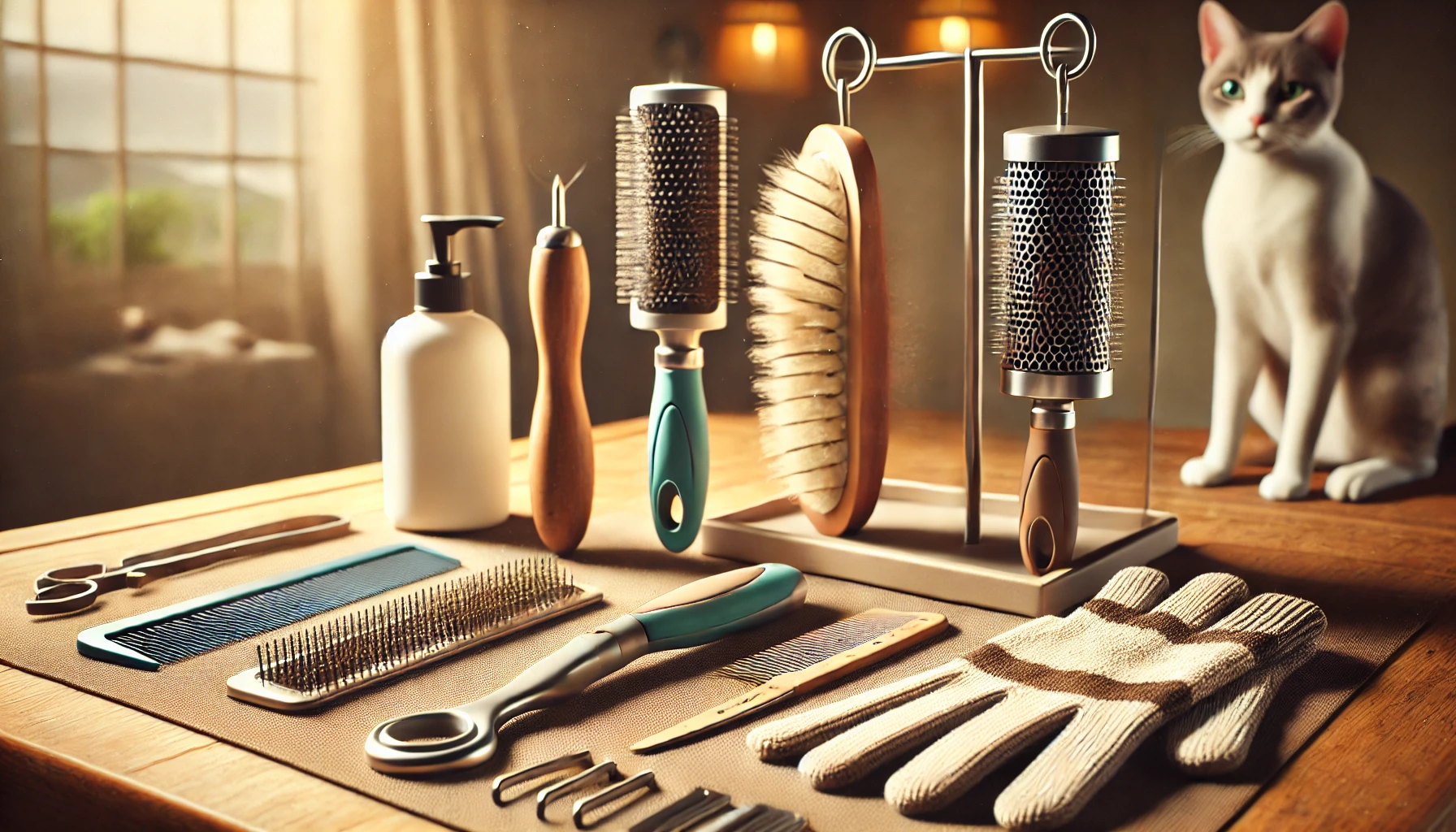
Preparing for Grooming: Tools and Techniques to Protect Skin
Before you start grooming your cat, it’s essential to use the proper tools and techniques to keep their skin intact and irritation-free.
The appropriate grooming tools prevent skin irritation, while gentle techniques help your cat remain relaxed, reducing the chances of harming their sensitive skin.
Here are some tools and methods to make grooming as safe and comfortable as possible for your feline friend.
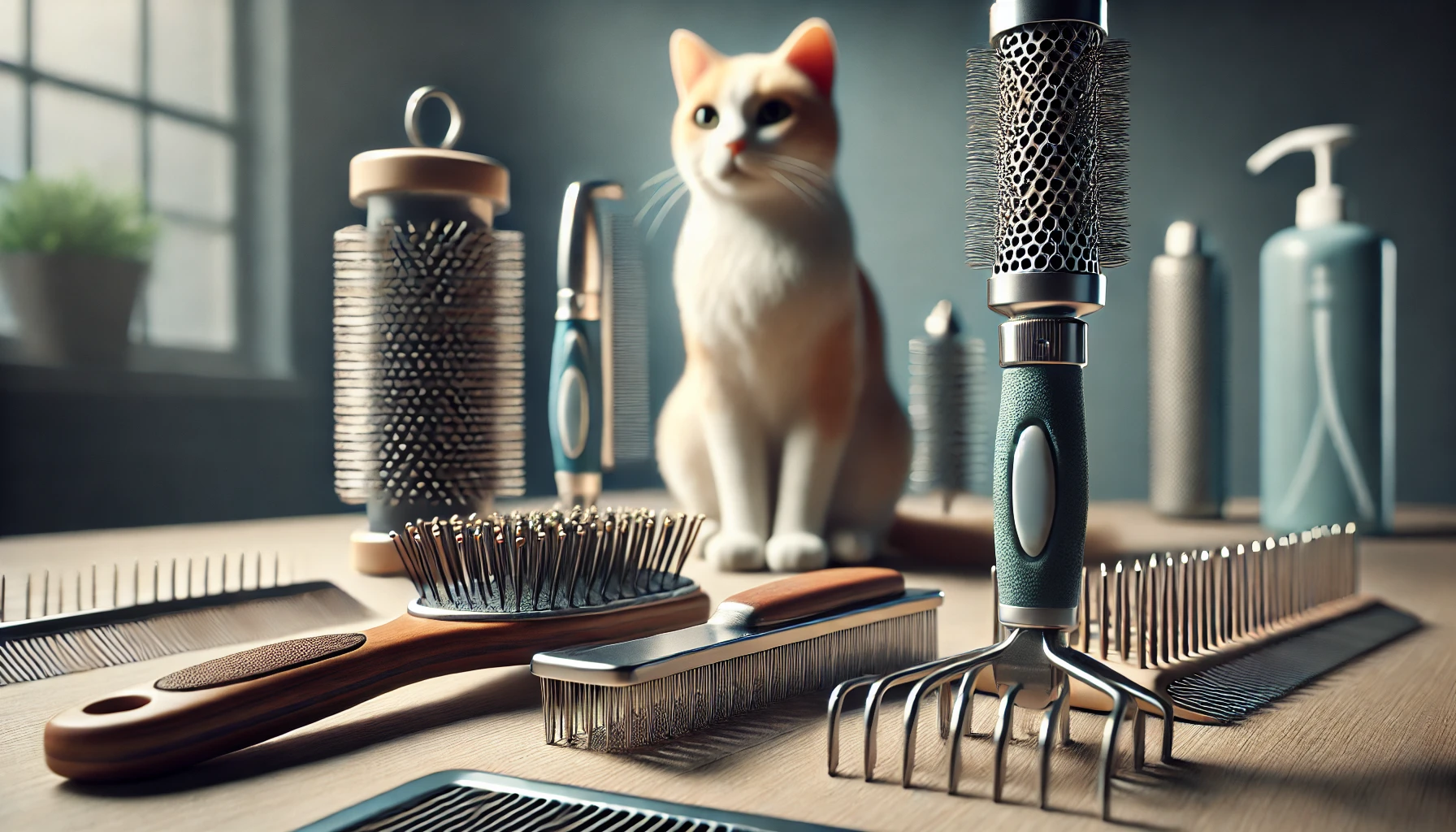
Choosing the Right Brushes and Combs for Sensitive Skin
Not all grooming brushes and combs are suitable for cats, especially for those with sensitive skin.
The right brush or comb should help remove loose fur and prevent matting without scratching or irritating your cat’s skin.
Consider these types of brushes and combs when grooming:
- Slicker brush: Ideal for cats with long or thick fur, a slicker brush has fine, short wires that gently tease out tangles without pulling too much on the skin.
- Bristle brush: Soft-bristle brushes work well for short-haired cats, helping to remove loose fur and distribute natural oils without causing skin irritation.
- Wide-tooth comb: Effective for detangling matted fur and preventing knots, especially in longer-haired cats. A wide-tooth comb is generally gentler on the skin than fine-tooth combs.
Start brushing your cat slowly and gently to avoid discomfort.
Observe their behavior to see if they show signs of discomfort.
If so, consider switching to a softer-bristle brush or a grooming glove that may be more soothing.
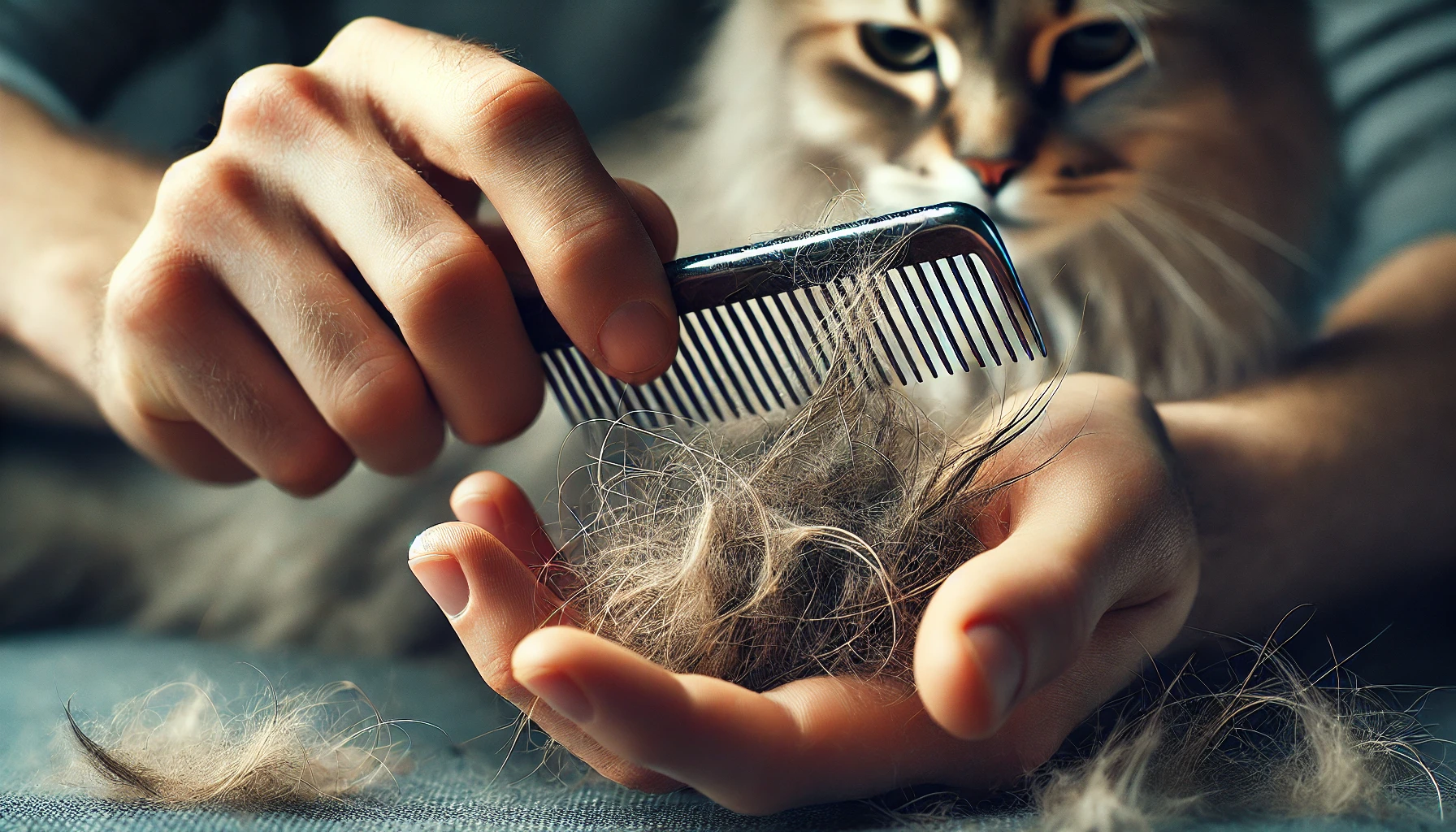
How to Handle Matted Fur Without Hurting the Skin
Matted fur is common in cats, especially those with dense or long coats.
When fur becomes tangled, it can pull on the skin and lead to discomfort or even skin infections.
To handle matted fur safely, try the following methods:
- Use a detangling spray: Cat-friendly detangling sprays can help loosen knots, making it easier to brush through matted areas without pulling on the skin.
- Start with your fingers: Gently work through the mat with your fingers before using a comb to reduce tension on your cat’s skin.
- Work gradually: Take your time and work in small sections. Trying to tackle large mats all at once can cause pain and stress for your cat.
If mats are particularly severe, consult a professional groomer or veterinarian to remove them safely, reducing the risk of skin injuries.
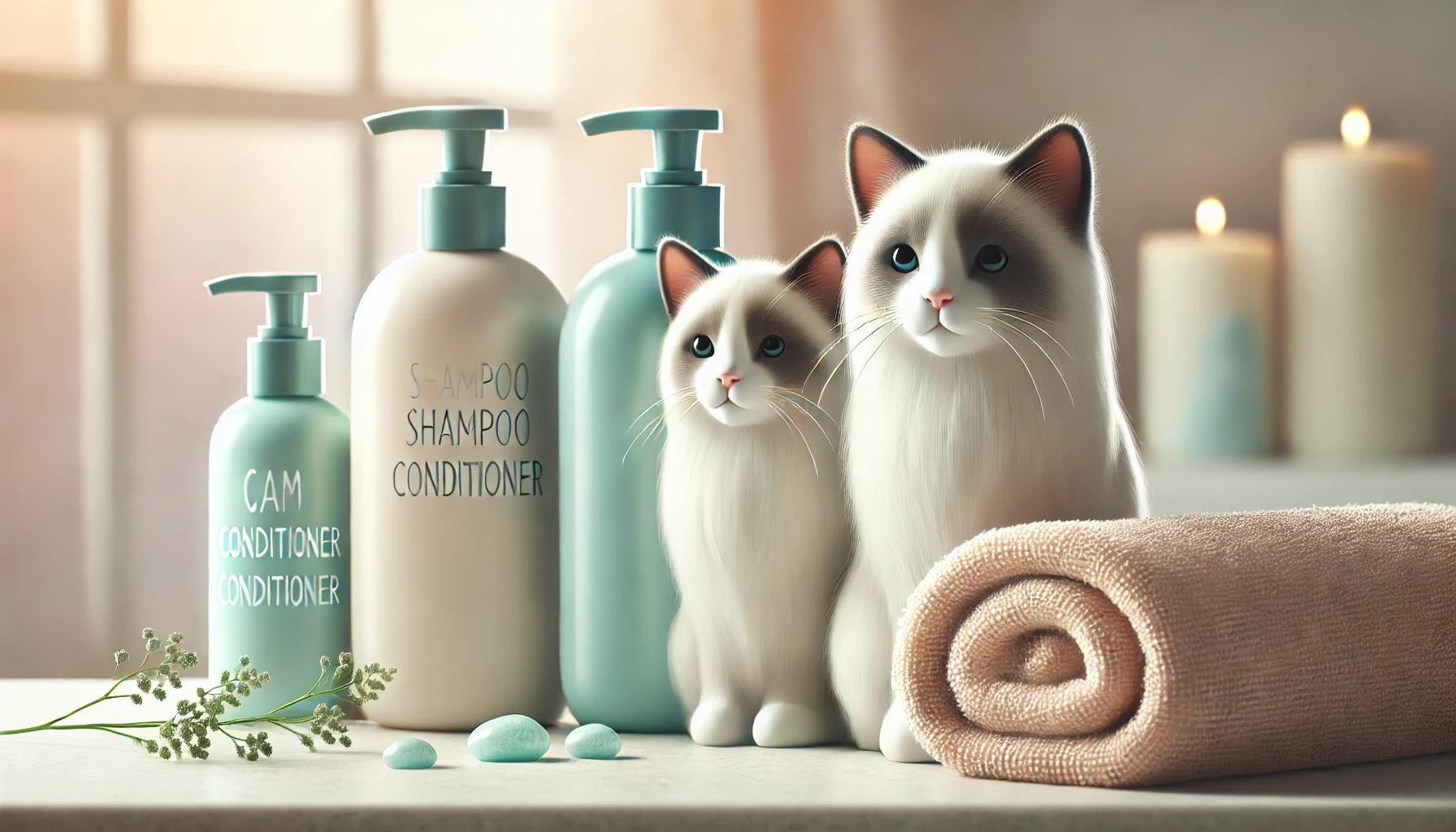
Using Cat-Friendly Shampoos and Conditioners
Cats have sensitive skin that can react poorly to products not specifically formulated for them.
Regular grooming products for dogs or humans can cause skin irritation or dryness in cats.
When choosing shampoos and conditioners, consider the following:
- Hypoallergenic formulas: Look for hypoallergenic, fragrance-free shampoos to minimize the risk of allergic reactions.
- Moisturizing ingredients: Shampoos with ingredients like oatmeal or aloe vera help keep your cat’s skin hydrated and soothe any existing irritation.
- Avoid harsh chemicals: Choose products free of parabens, sulfates, and artificial fragrances, as these can irritate a cat’s sensitive skin.
Always rinse your cat thoroughly to remove all shampoo residue, as leftover product can lead to skin irritation.
Cats often lick their fur, so ensuring the product is entirely rinsed out is crucial for their skin and overall health.

Setting Up a Comfortable Grooming Environment
A comfortable, stress-free environment is essential for successful grooming, especially when it involves checking for skin issues.
A calm setting helps your cat feel more at ease, reducing the likelihood of sudden movements that might lead to skin injury.
Here are a few tips for creating a cat-friendly grooming space:
- Choose a quiet space: Select a room with minimal noise and distractions to help your cat relax.
- Use a non-slip surface: Place a towel or mat on your grooming table to prevent slipping, making your cat feel more secure and less anxious.
- Have treats ready: Rewarding your cat with treats during and after grooming helps create positive associations with the experience, making future grooming sessions easier.
By preparing properly, using suitable tools, and applying gentle techniques, you can make grooming a pleasant and safe activity for your cat, while also taking the opportunity to monitor their skin health closely.
Grooming Tools for Cat Skin Health
Choosing the right grooming tools helps avoid skin irritation. Use gentle techniques to make grooming a safe experience.
- Slicker brush: Good for detangling long fur.
- Bristle brush: Effective for short-haired cats.
- Wide-tooth comb: Helpful for detangling matted fur.
Observe your cat’s behavior to identify any discomfort, and use gentle, soothing techniques.
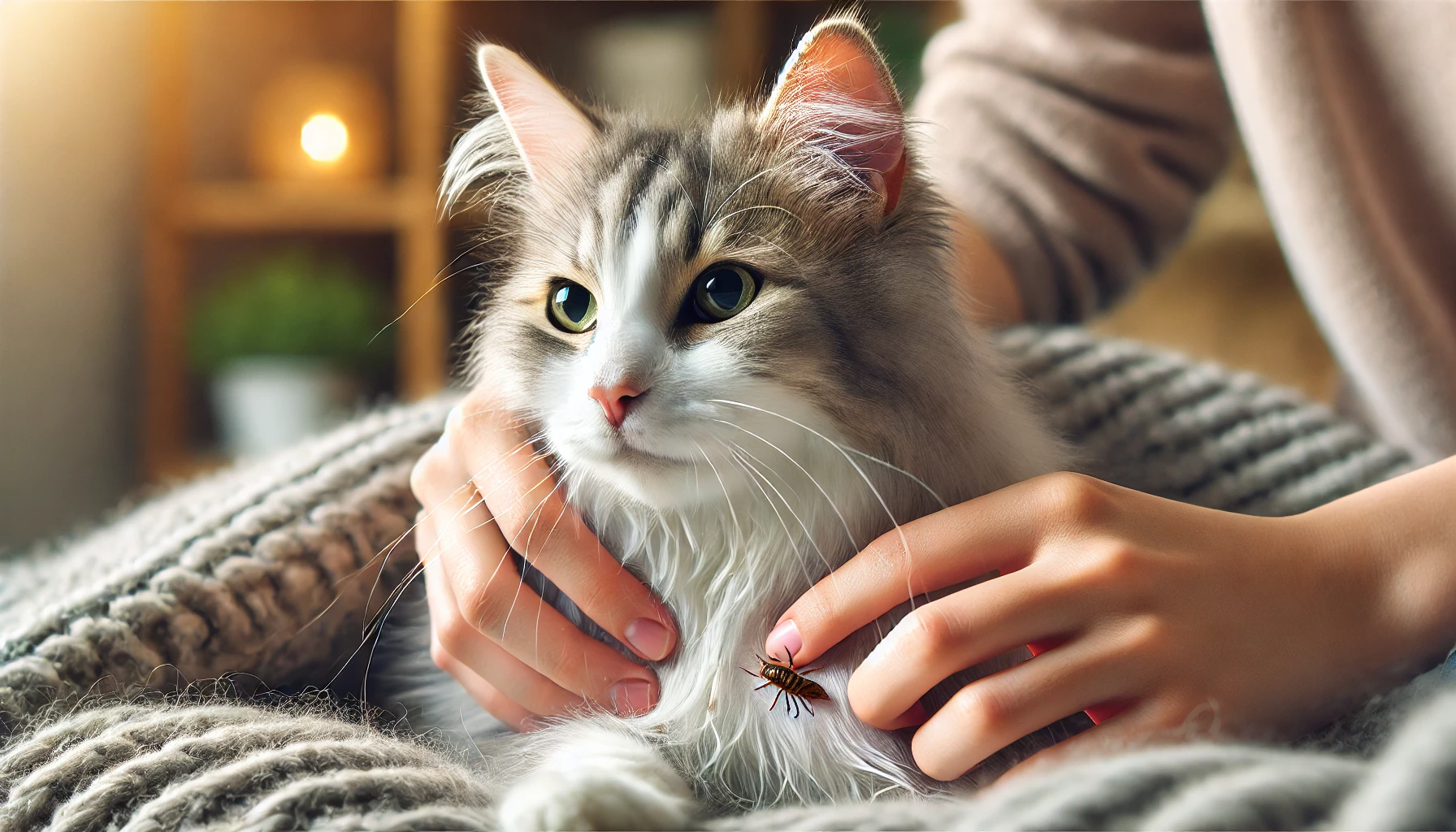
Detecting Parasites and Their Impact on Cat Skin Health
Parasites are among the most common causes of skin issues in cats and can significantly impact your cat’s health and comfort.
Fleas, ticks, and mites are the most frequent parasites affecting cats, each causing different types of irritation and discomfort.
Recognizing the signs of these parasites and knowing how to manage them is crucial in protecting your cat’s skin and overall well-being.
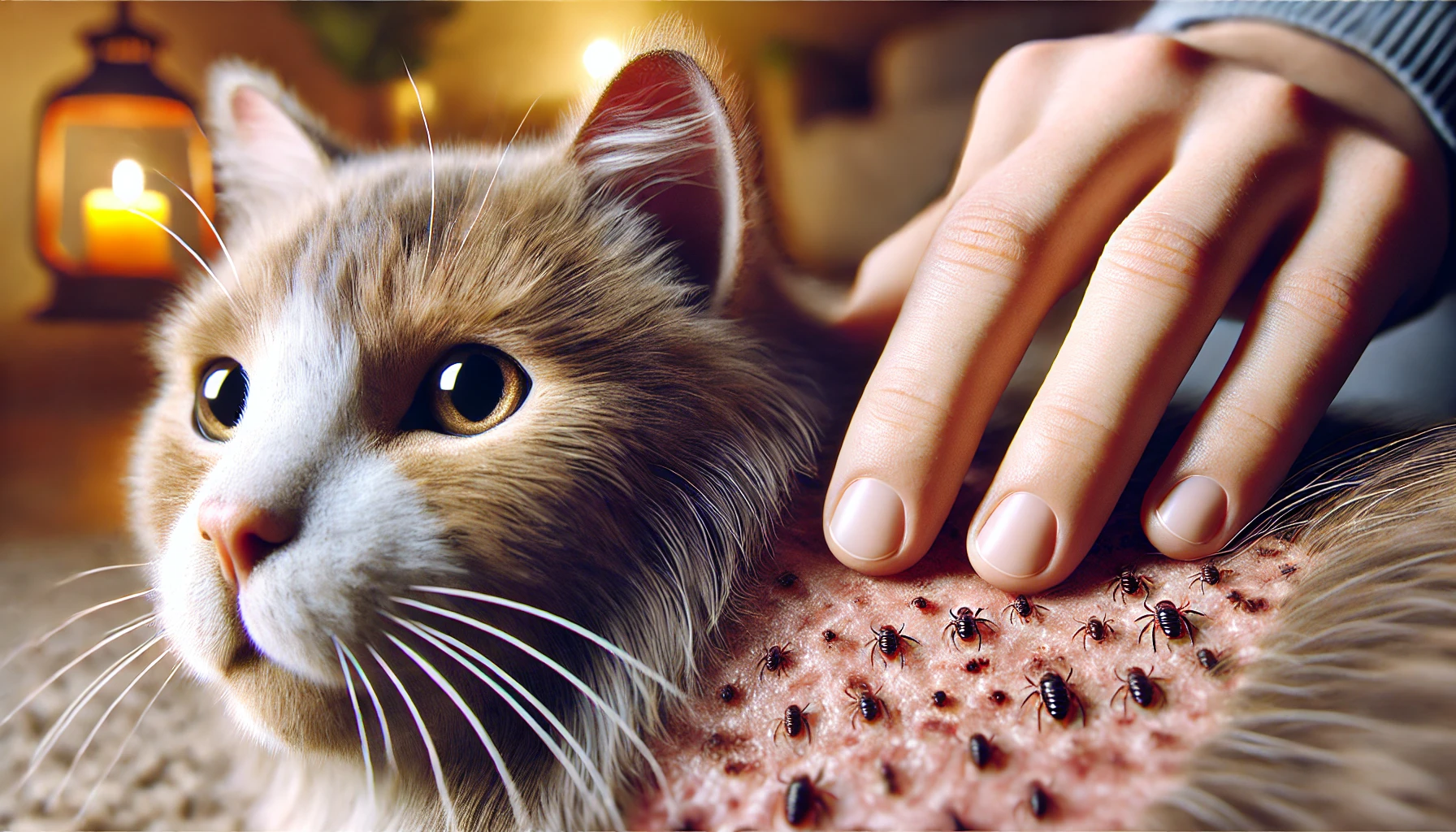
Identifying Fleas and Their Skin Symptoms
Fleas are small, elusive parasites that can quickly infest a cat’s coat, causing persistent itching and irritation.
A single flea can lay several hundred eggs, leading to a rapid infestation.
Signs of flea presence on your cat’s skin include:
- Excessive scratching and grooming: Flea bites are intensely itchy, often causing your cat to scratch or bite at their skin, sometimes resulting in hair loss.
- Red bumps or scabs: Flea bites often appear as small red bumps, particularly around the neck, base of the tail, and belly.
- “Flea dirt”: Flea dirt, which resembles small black specks, can often be found on a cat’s skin or bedding. This flea feces is a strong indicator of an active flea infestation.
If you suspect fleas, use a flea comb to check for flea dirt or small black fleas.
Consult your veterinarian about appropriate flea treatments to eradicate the infestation and relieve your cat’s discomfort.
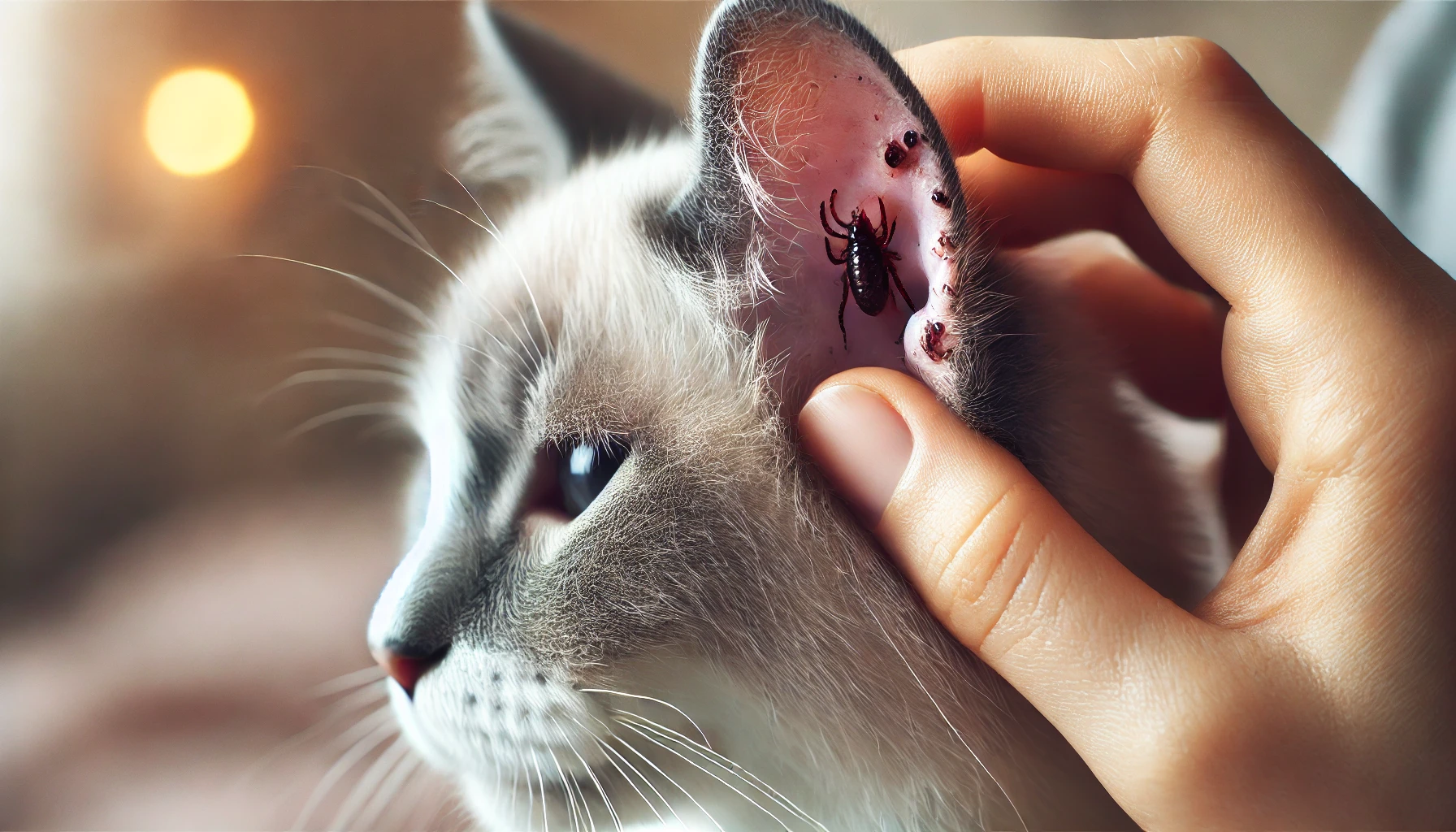
Recognizing Signs of Ticks and Mites
Ticks and mites are other common parasites that can cause skin issues in cats.
Ticks are visible to the naked eye and attach themselves to your cat’s skin to feed, while mites are microscopic and harder to detect.
Here are some ways to identify their presence:
- Ticks: Ticks appear as small, round elevations on your cat’s skin, often found around the neck, ears, and between the toes. They can cause irritation, redness, and even swelling at the site of attachment.
- Mites: Mites, such as ear mites, cause severe itching, especially around the ears. You may notice black or brown waxy buildup in the ear canal, along with head shaking and scratching.
Ticks should be removed carefully using a tick remover tool or by a veterinarian to avoid leaving parts embedded in the skin, which could lead to infection.
Mite infestations require veterinary treatment, as specific medications are needed to eliminate the infection.
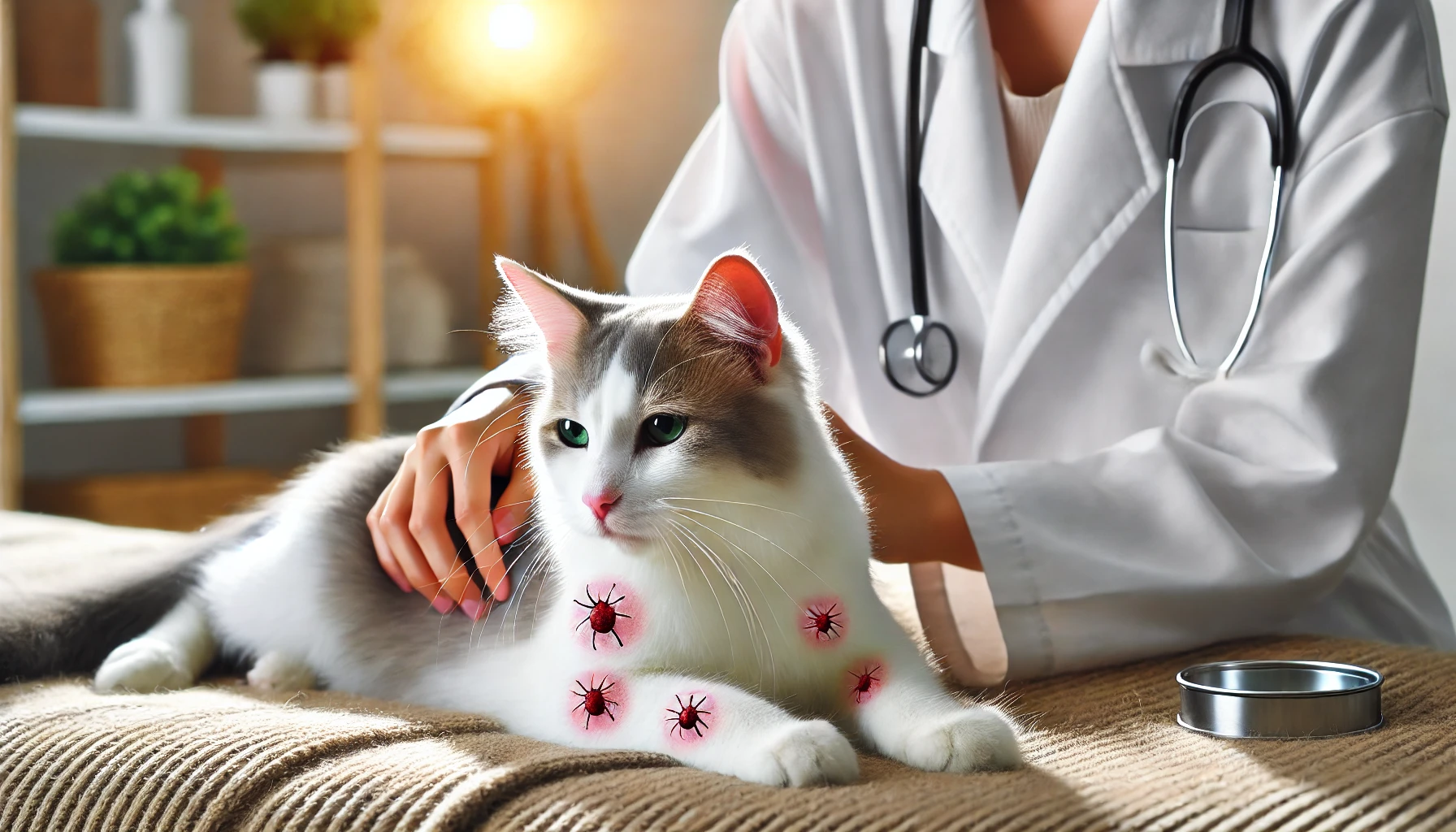
Managing Allergic Reactions from Parasite Bites
Some cats develop an allergy to flea and parasite bites, leading to more severe skin reactions such as flea allergy dermatitis (FAD).
This condition can cause intense itching, inflammation, and even secondary infections due to excessive scratching.
Symptoms of allergic reactions to parasite bites include:
- Hot spots: Red, inflamed patches where the cat has scratched or bitten intensely, often resulting in hair loss.
- Scabbing and sores: Areas affected by flea allergy dermatitis may have scabs or sores due to self-inflicted wounds.
- Swelling and redness: The skin around bite sites may become swollen and red from the allergic reaction.
If your cat shows signs of an allergic reaction, consult your veterinarian.
They may prescribe medications to help manage the allergy and recommend effective parasite control products to prevent future bites.
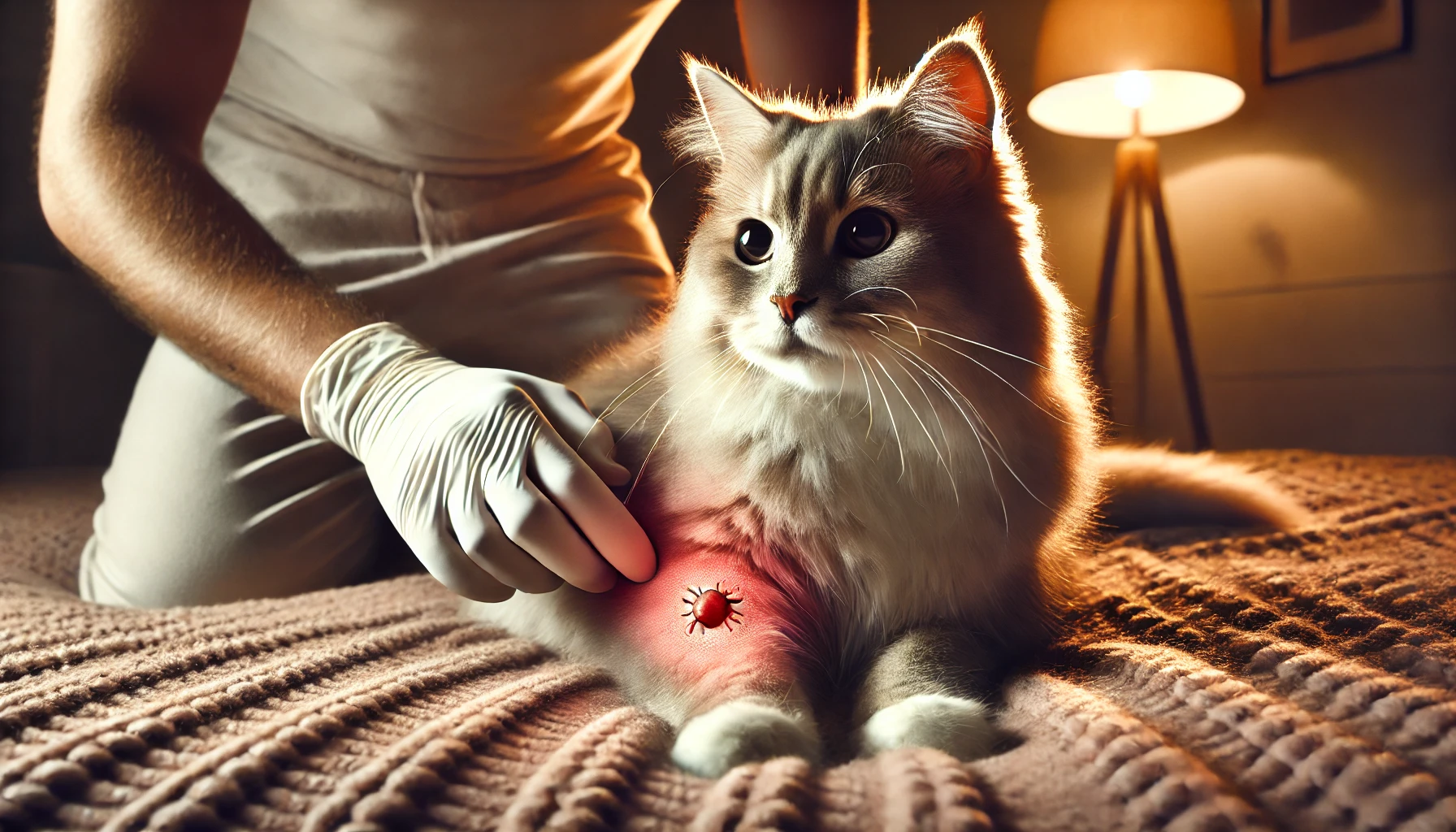
Understanding Skin Irritation from Flea Treatments
While flea treatments are essential for parasite control, some products can irritate a cat’s skin, especially if they contain harsh chemicals or are not formulated for feline use.
Signs of skin irritation from flea treatments include:
- Redness or inflammation at the application site: If the skin where the treatment was applied becomes red or inflamed, it could be a reaction to the product.
- Excessive licking or scratching: Cats may excessively groom the area where the product was applied if it causes discomfort or irritation.
- Skin peeling or hair loss: In severe cases, the skin around the application site may peel, or hair loss might occur.
If you notice any of these reactions, contact your veterinarian.
They may suggest switching to a gentler product or prescribing treatments to soothe your cat’s skin.
Always use flea treatments specifically designed for cats, and avoid using products intended for dogs, as they can be toxic to felines.
Effective management of parasites helps maintain your cat’s skin health, ensuring they remain comfortable and free from the irritation caused by infestations.
Parasite Warning Signs
Parasites like fleas, ticks, and mites can cause severe skin discomfort. Spotting signs early can prevent infestations.
- Fleas: Excessive scratching, red bumps, and flea dirt.
- Ticks: Visible on the skin, often around ears and neck.
- Mites: Cause intense itching, often around ears.
Consult your veterinarian for proper parasite treatment options.
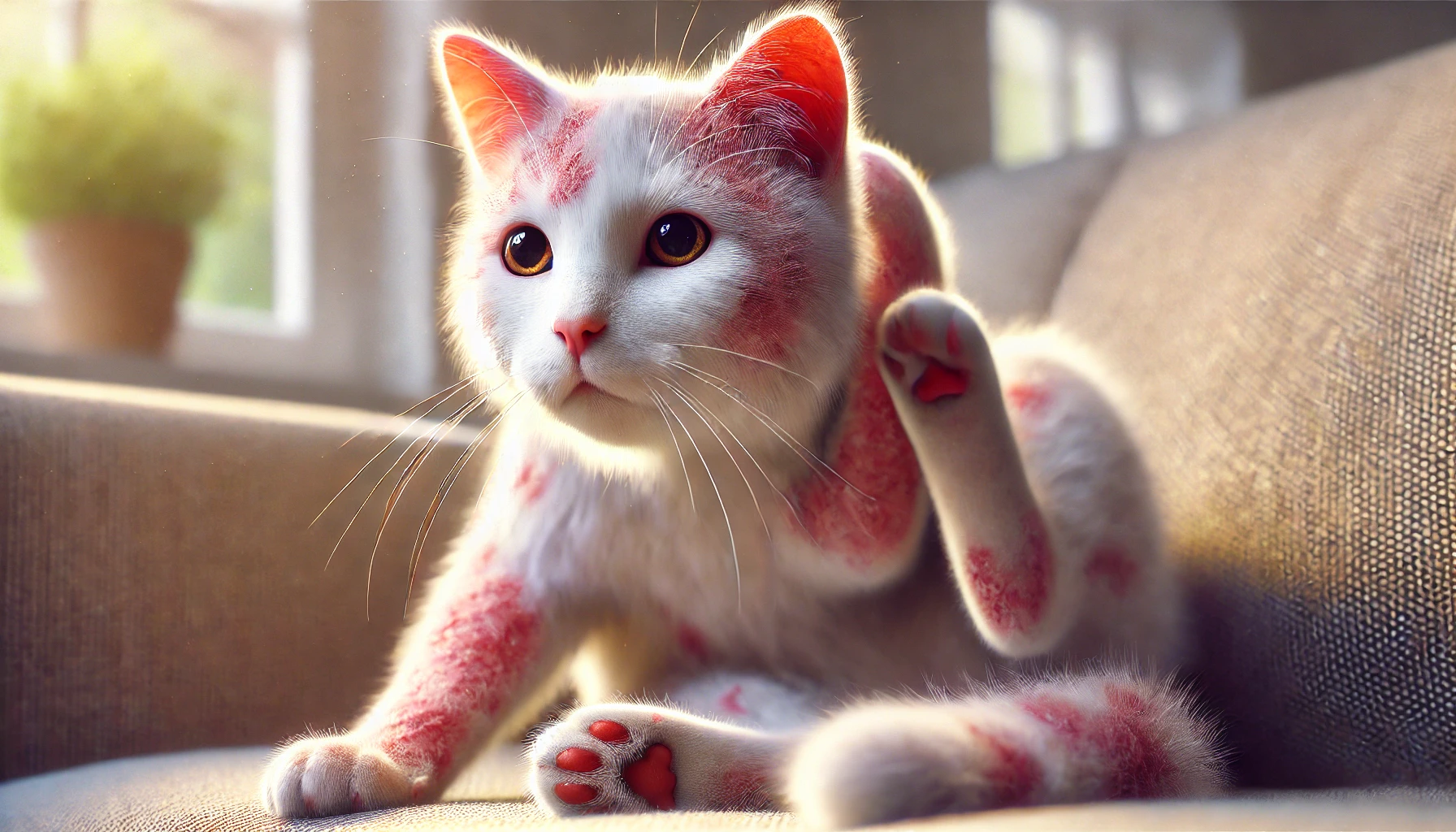
Signs of Allergies and Skin Sensitivities in Cats
Like humans, cats can also develop allergies or sensitivities, many of which manifest through skin disorders.
These sensitivities may stem from food-based allergens, environmental factors, or even reactions to grooming products.
Identifying the type of allergy affecting your cat allows you to start treatment early, helping to relieve your cat’s discomfort.
Below, we discuss common signs and types of allergies in cats, along with management tips.
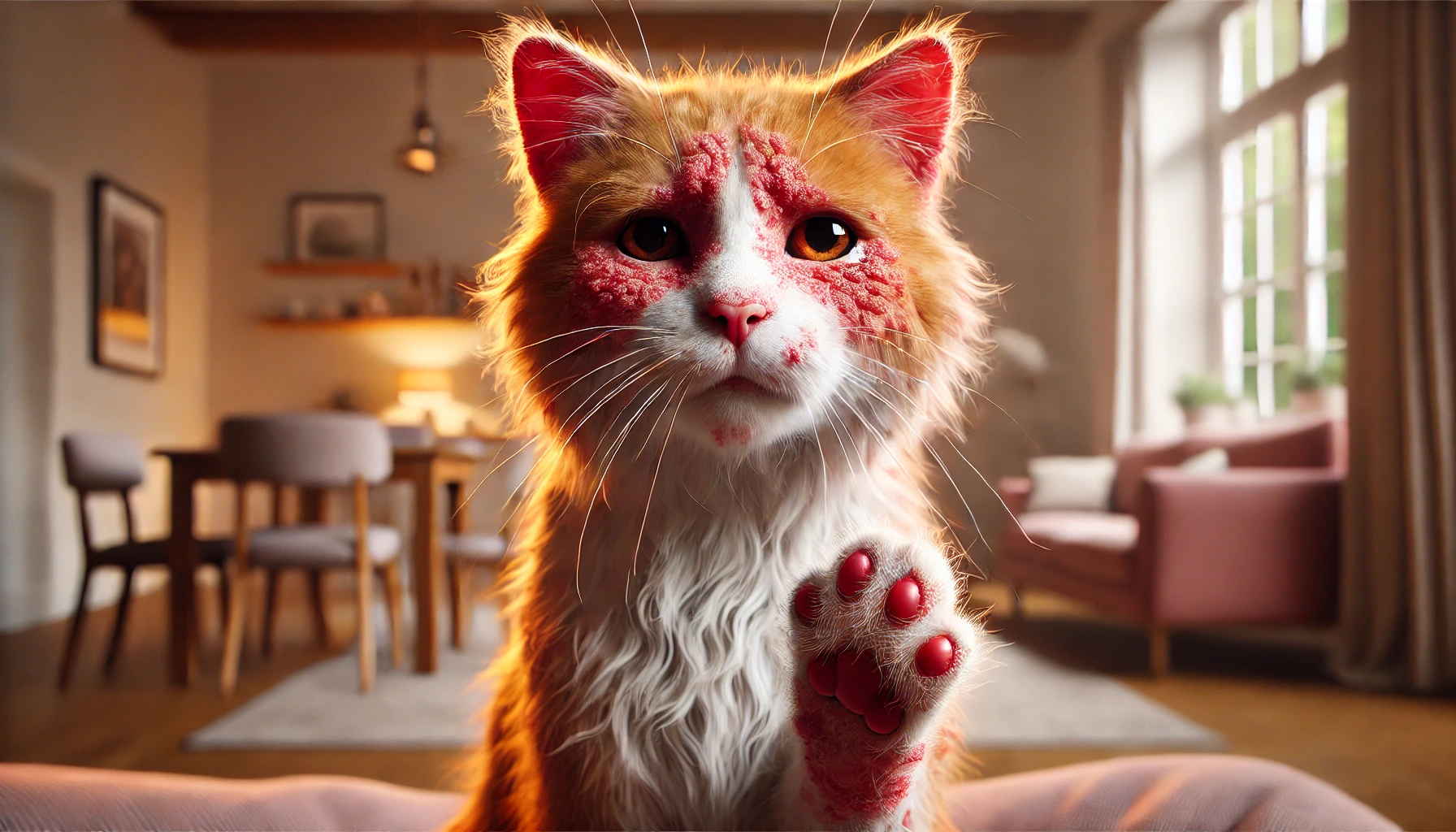
Symptoms of Food Allergies on Cat Skin
Food allergies in cats are less common than environmental allergies but can still cause significant discomfort.
When a cat develops an allergy to certain ingredients, it often appears in the form of skin symptoms.
Common signs of food allergies include:
- Itchy skin: Cats with food allergies frequently scratch or lick their skin excessively, especially around the face, neck, and ears.
- Red, irritated patches: You may notice red, itchy areas on your cat’s skin, often where they scratch or lick frequently.
- Chronic ear infections: Recurring ear infections can also be a sign of food allergies in cats, as allergens may cause irritation in the ear canals.
If you suspect a food allergy, consult your veterinarian.
They may recommend an elimination diet to isolate the offending ingredient and suggest hypoallergenic cat food to reduce skin reactions.

Environmental Allergies: Dust, Pollen, and More
Environmental allergens, such as dust, pollen, and mold, can cause skin reactions in cats.
Depending on your cat’s exposure, these can lead to seasonal allergies or ongoing sensitivities.
Symptoms of environmental allergies include:
- Excessive scratching and biting: Cats with environmental allergies may scratch or bite at their skin, leading to hair loss and irritated patches.
- Red, watery eyes: Environmental allergies may also cause redness and watering of the eyes, with frequent face rubbing.
- Sneezing and nasal discharge: In some cases, respiratory symptoms may accompany skin issues caused by environmental allergens.
Minimizing your cat’s exposure to allergens by maintaining a clean environment and using air purifiers can help alleviate symptoms.
Your veterinarian may also prescribe antihistamines or other medications for severe reactions.

Behavioral Signs Indicating Skin Discomfort
Behavioral changes are often the first indicators of skin allergies or sensitivities.
Recognizing these signs can help you detect skin discomfort in your cat early.
Common behavioral signs include:
- Excessive grooming: Cats with allergies may groom specific areas of their body excessively, sometimes causing bald spots.
- Increased irritability: Cats in discomfort may become more irritable or even aggressive when touched, especially in sensitive areas.
- Hiding or avoidance: Cats experiencing skin discomfort may hide or avoid interaction.
Observing these behaviors can indicate that your cat is experiencing skin sensitivity.
A veterinarian can help diagnose the underlying cause and provide relief.
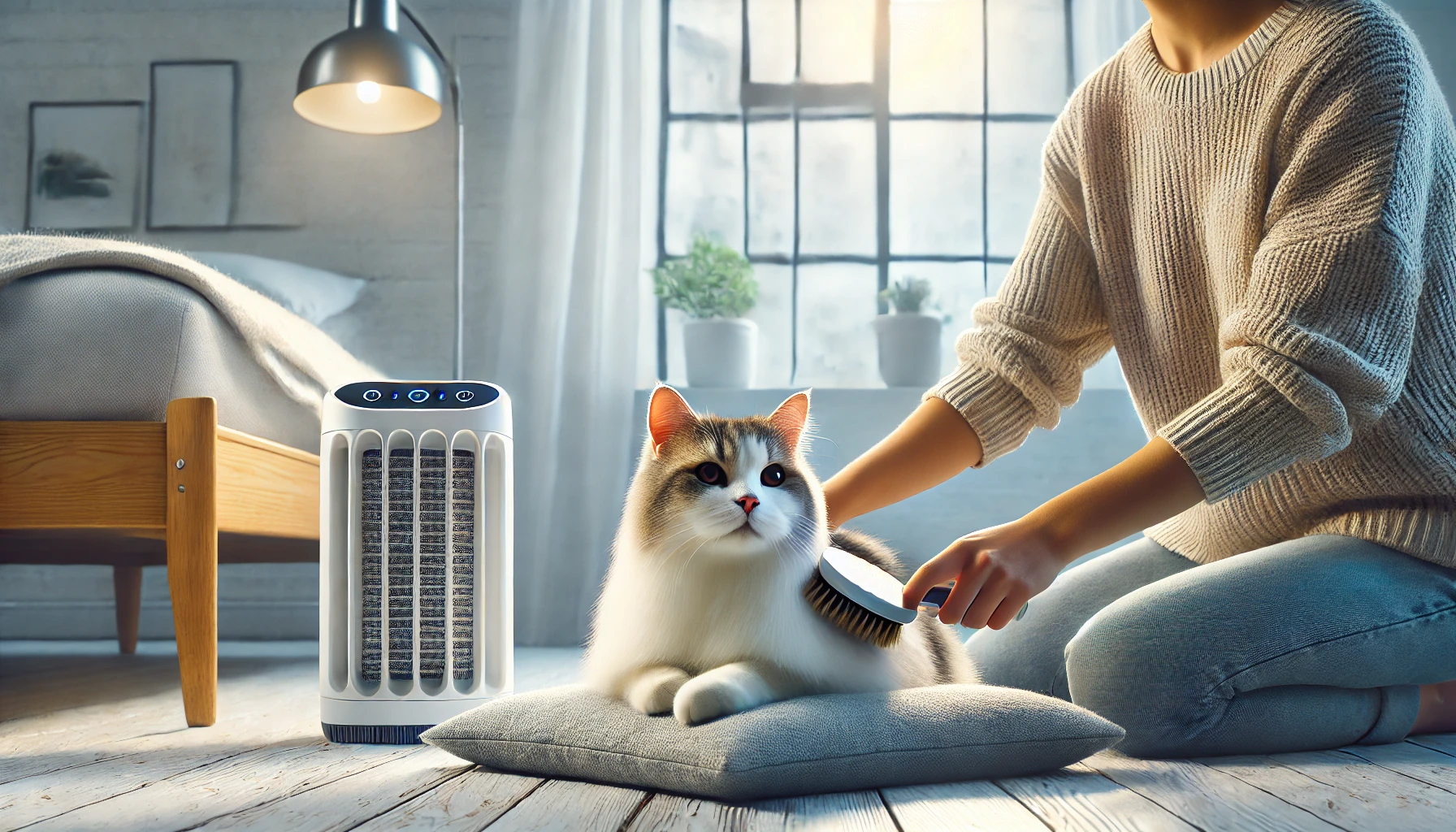
Steps to Reduce Allergy-Related Skin Issues
Effectively managing your cat’s allergies can greatly improve their skin health.
Here are some steps you can take to reduce allergy-related skin problems:
- Introduce hypoallergenic diets: A hypoallergenic diet can prevent flare-ups related to food allergies and improve your cat’s skin health.
- Minimize exposure to allergens: Reducing dust, using air purifiers, and washing your cat’s bedding regularly can limit exposure to environmental allergens.
- Use cat-friendly grooming products: Choosing grooming products formulated for cats can help avoid skin sensitivities triggered by harsh chemicals.
- Medications: For severe cases, your vet may prescribe antihistamines, corticosteroids, or topical treatments to help manage symptoms.
By recognizing the symptoms of allergies, you can take appropriate action to alleviate your cat’s skin sensitivities, keeping their coat healthy and reducing discomfort caused by allergens.
Identifying Allergies in Cats
Allergies can cause skin irritations, itchiness, and discomfort in cats.
- Food allergies: Often appear as itchy skin, red patches, or chronic ear infections.
- Environmental allergens: Symptoms include scratching, red eyes, and sneezing.
Reducing allergens in the environment and consulting a vet for severe reactions can help manage these issues.
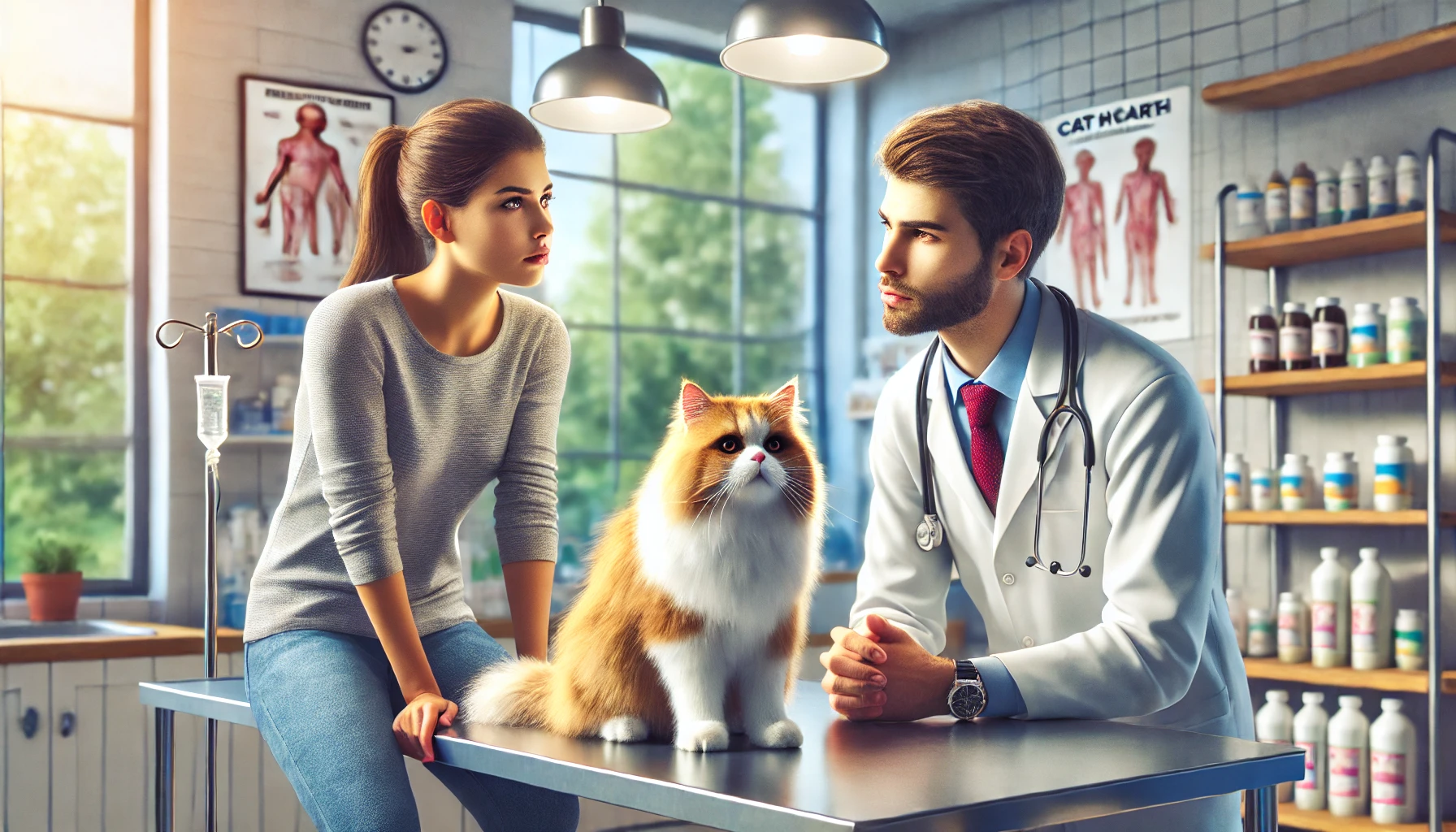
When to Consult a Vet About Your Cat’s Skin Health
While many skin conditions in cats can be managed at home with proper grooming and care, certain symptoms require veterinary attention.
Cats can develop various skin issues that may signal underlying health problems.
Knowing when to consult a vet allows you to address potential issues before they worsen.
Here are some signs that it’s time to seek professional advice regarding your cat’s skin health.
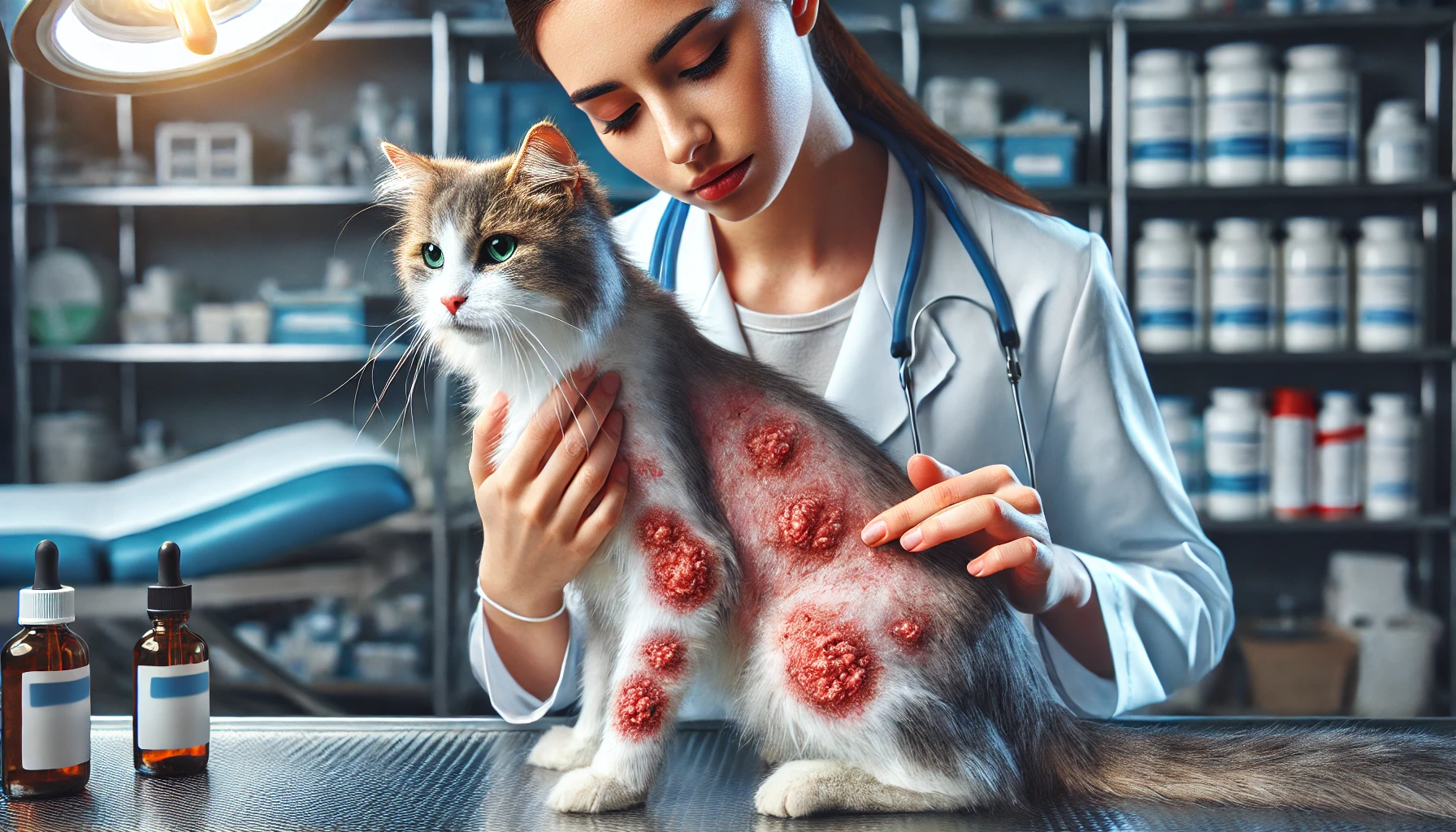
Persistent or Worsening Skin Problems
If your cat displays skin issues that don’t resolve with at-home care, or if the symptoms worsen, it’s important to consult your vet.
Chronic issues like itching, redness, or rashes that fail to improve may indicate an infection, allergy, or immune system disorder.
Signs of a persistent skin condition include:
- Constant scratching or licking: When your cat repeatedly scratches or licks the same area, resulting in hair loss or irritated, raw skin, a vet should evaluate the underlying cause.
- Unresolved redness and swelling: Areas of redness and swelling that do not subside or that spread could indicate an infection or inflammation that needs treatment.
- Open sores or wounds: Non-healing or worsening ulcers are often a sign of infection or a deeper issue.
Veterinary treatment can help alleviate these symptoms and prevent further complications.
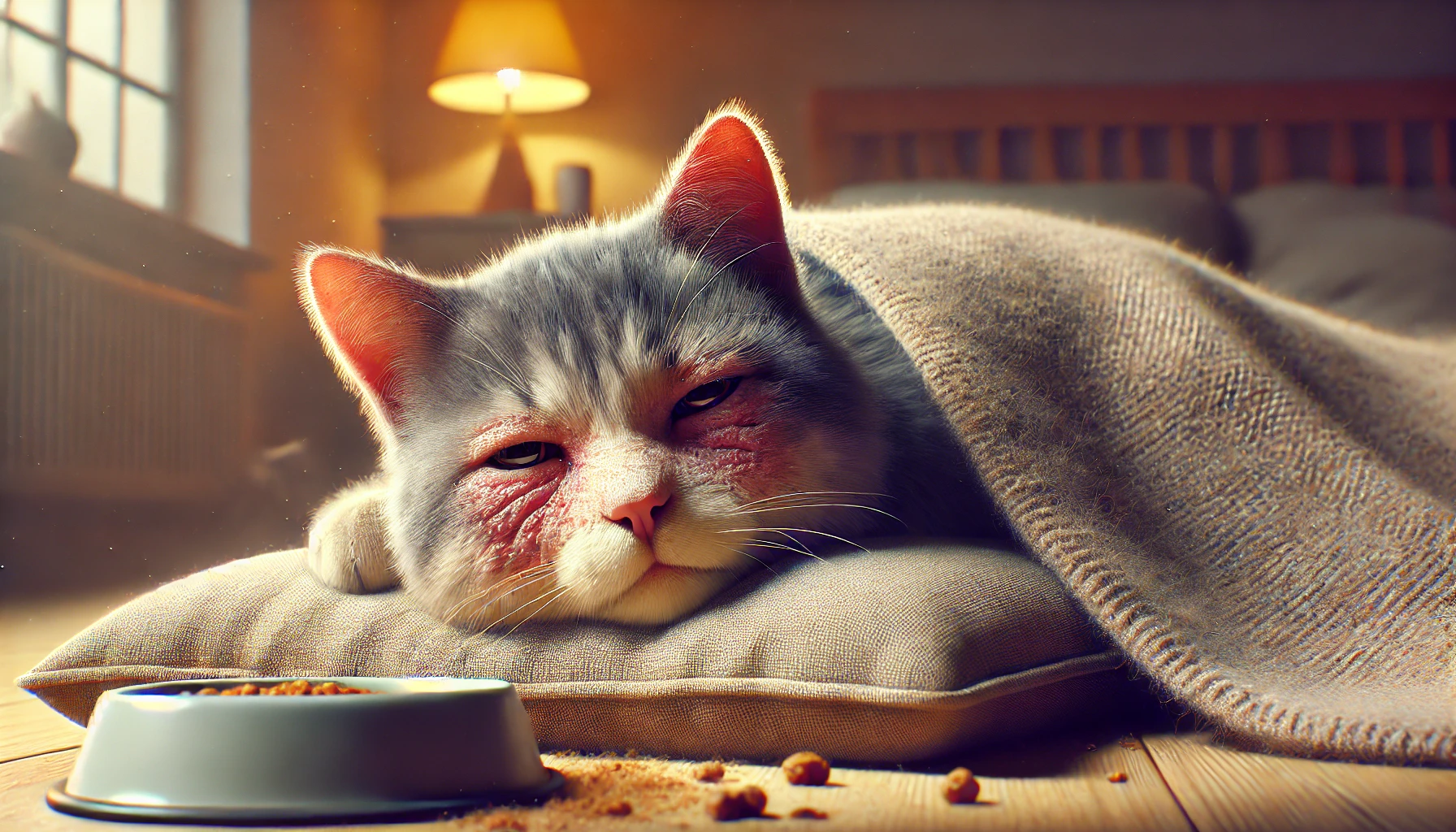
Skin Changes Along with Lethargy or Loss of Appetite
Skin issues paired with general signs such as lethargy or loss of appetite may indicate a more serious health concern.
Since cats are known to hide signs of discomfort, skin problems that manifest alongside changes in energy or appetite should be taken seriously.
Potential causes include systemic infections, hormonal imbalances, or internal parasites.
If you observe any of the aforementioned skin problems, along with symptoms like lethargy or appetite loss, consult your vet.
Early diagnosis can be critical in addressing conditions that affect the skin and overall health.
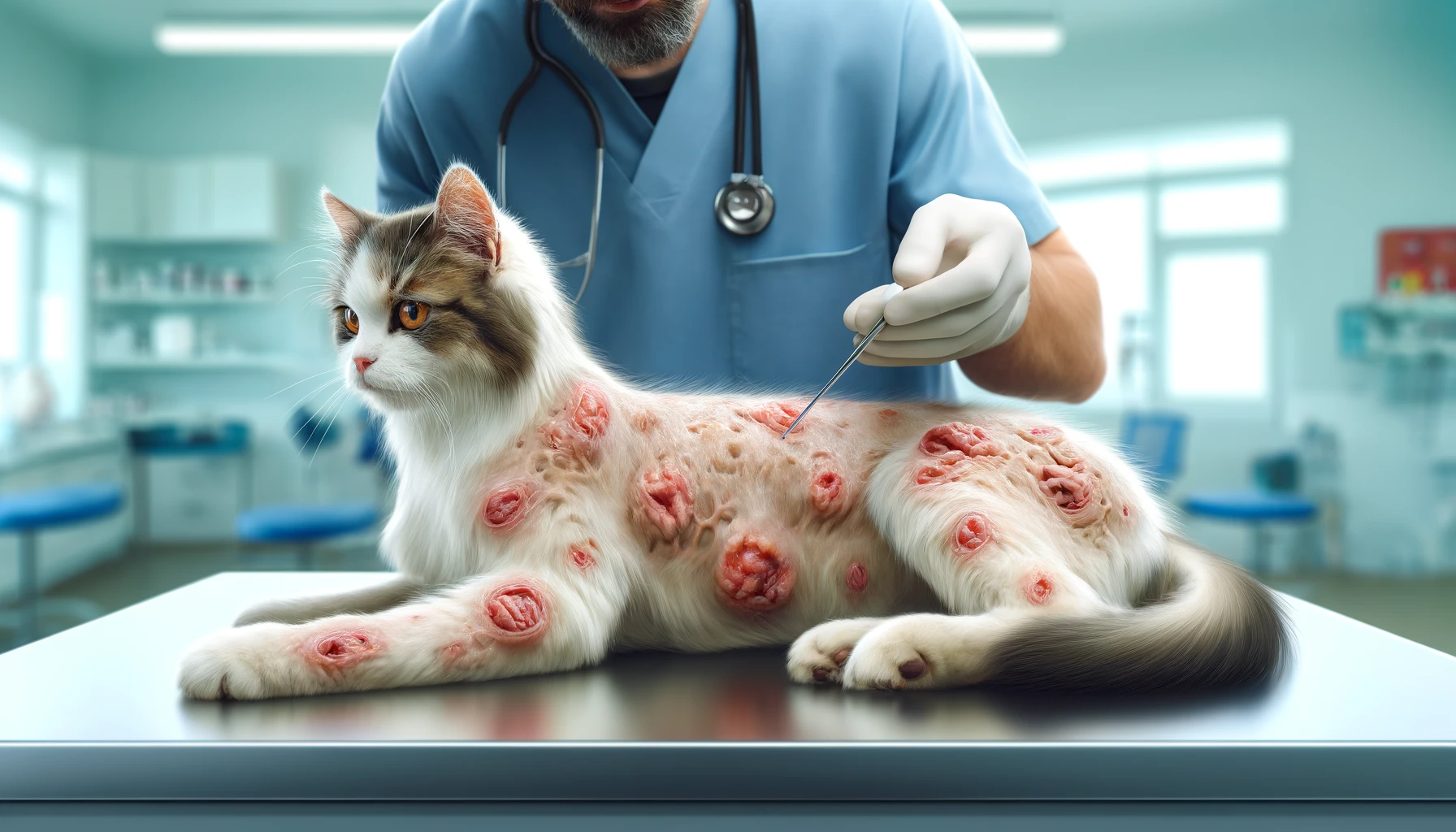
Recurrent Infections and Open Sores
Recurrent infections, especially those involving open sores, suggest a breach in the skin’s integrity.
If your cat suffers from recurring infections, this could indicate immune system issues or chronic allergies.
Recurrent infections may appear as:
- Pus or discharge from sores: Yellow or green discharge from a sore is often a sign of bacterial infection.
- Crusty or scabbed-over areas: Unhealed crusts or scabs may suggest chronic irritation or an ongoing infection.
- Foul odor: Infected skin can emit an unpleasant odor, indicating the need for veterinary care.
Your veterinarian can conduct diagnostic tests to identify the cause of these infections and may prescribe antibiotics or other treatments as needed.
It’s always advisable to consult a vet with experience in handling such cases.
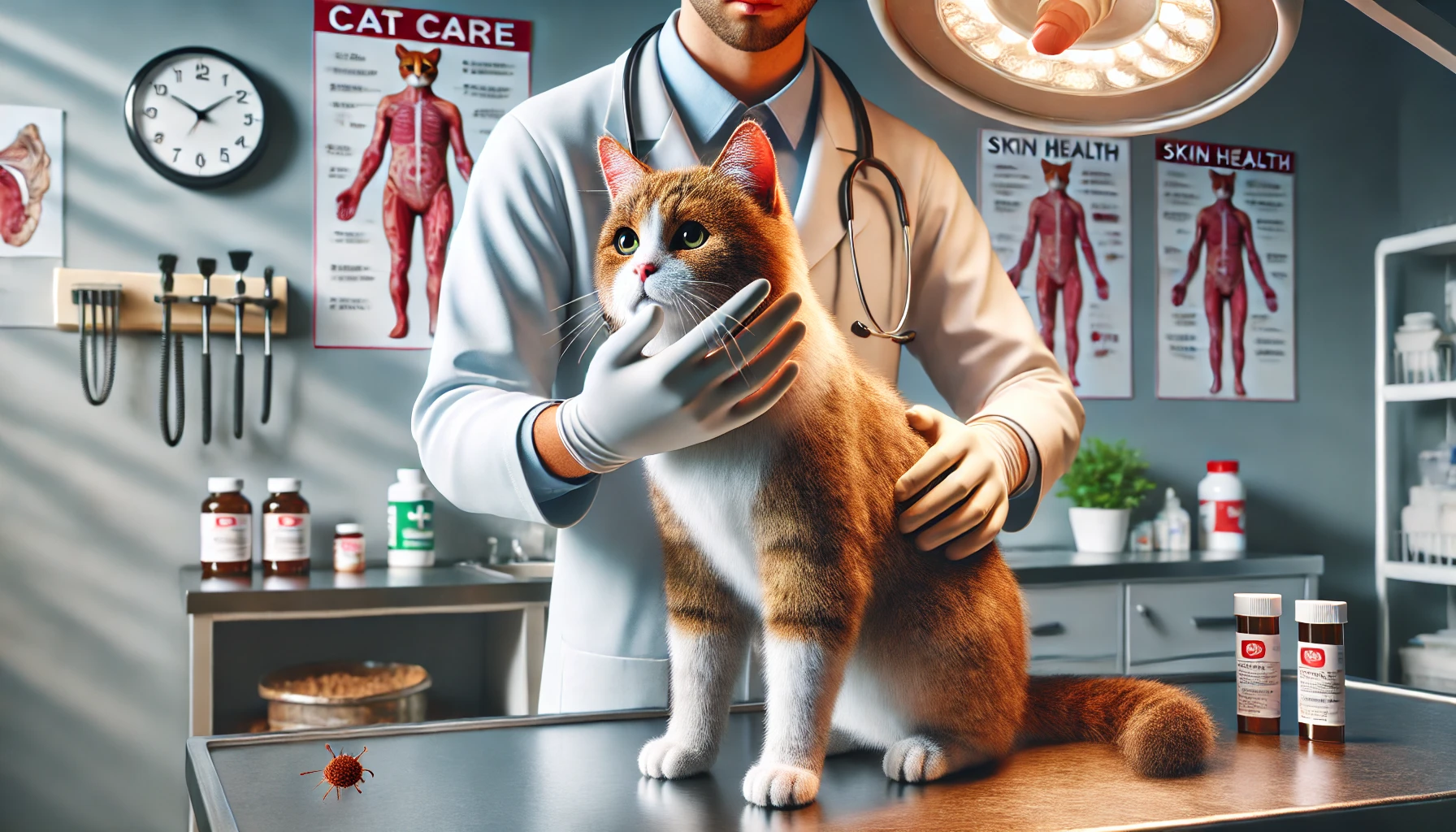
Guidelines for Routine Skin Health Checkups
Regular veterinary checkups are essential for maintaining your cat’s skin health, especially if they are prone to allergies or sensitivities.
Routine checkups enable your vet to catch early signs of skin problems and provide advice on preventive care.
Here’s what to consider for regular skin health checkups:
- Annual examinations: Schedule a full health checkup at least once a year, where the vet can examine your cat’s skin for any abnormalities.
- Monitoring at-risk cats: Cats with a history of skin issues or allergies may need more frequent visits to keep symptoms under control.
- Vaccinations and parasite control: Keeping your cat up-to-date on vaccinations and on a reliable parasite control program helps prevent skin problems caused by pests or infections.
By knowing when to seek veterinary help and adhering to regular skin health routines, you can help keep your cat comfortable and maintain their skin in optimal condition.
When to Seek Veterinary Help
Persistent or worsening skin problems may require veterinary care to prevent further complications.
- Chronic itching and redness.
- Non-healing sores or infections.
- Skin changes accompanied by lethargy or appetite loss.
Early intervention can prevent serious health issues and ensure proper care for your cat.
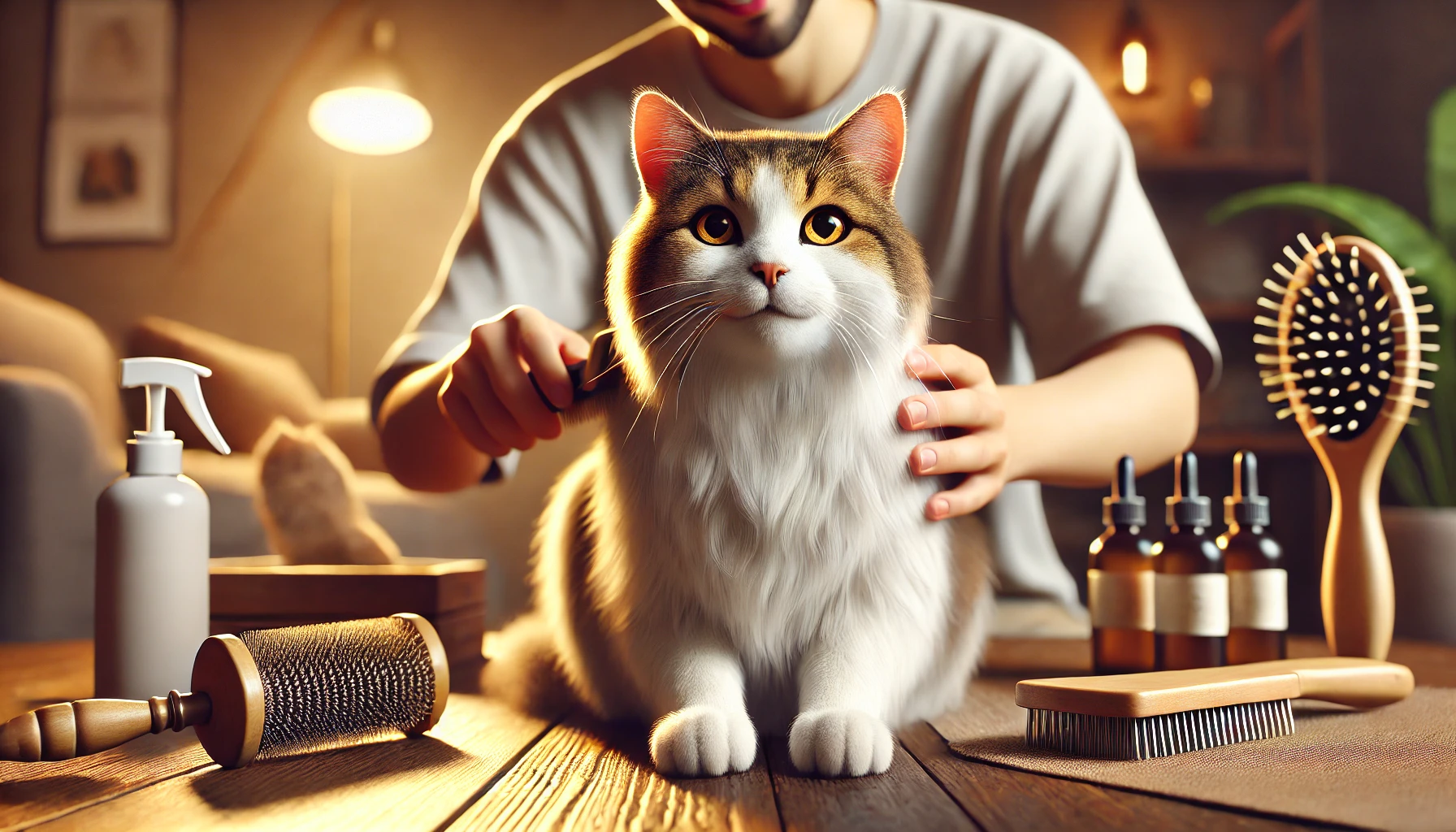
Key Takeaways: Maintaining Your Cat’s Skin Health During Grooming
Grooming is an essential part of your cat’s overall health care routine and one of the best ways to monitor their skin health.
Detecting skin issues early, understanding the signs, and knowing when professional help is necessary can make a significant difference in enhancing your cat’s comfort and well-being.
This guide has covered the key aspects of identifying, managing, and preventing skin irritations, allergies, and sensitivities while grooming your cat.
Let’s review the main points for keeping your feline friend’s skin in excellent condition.
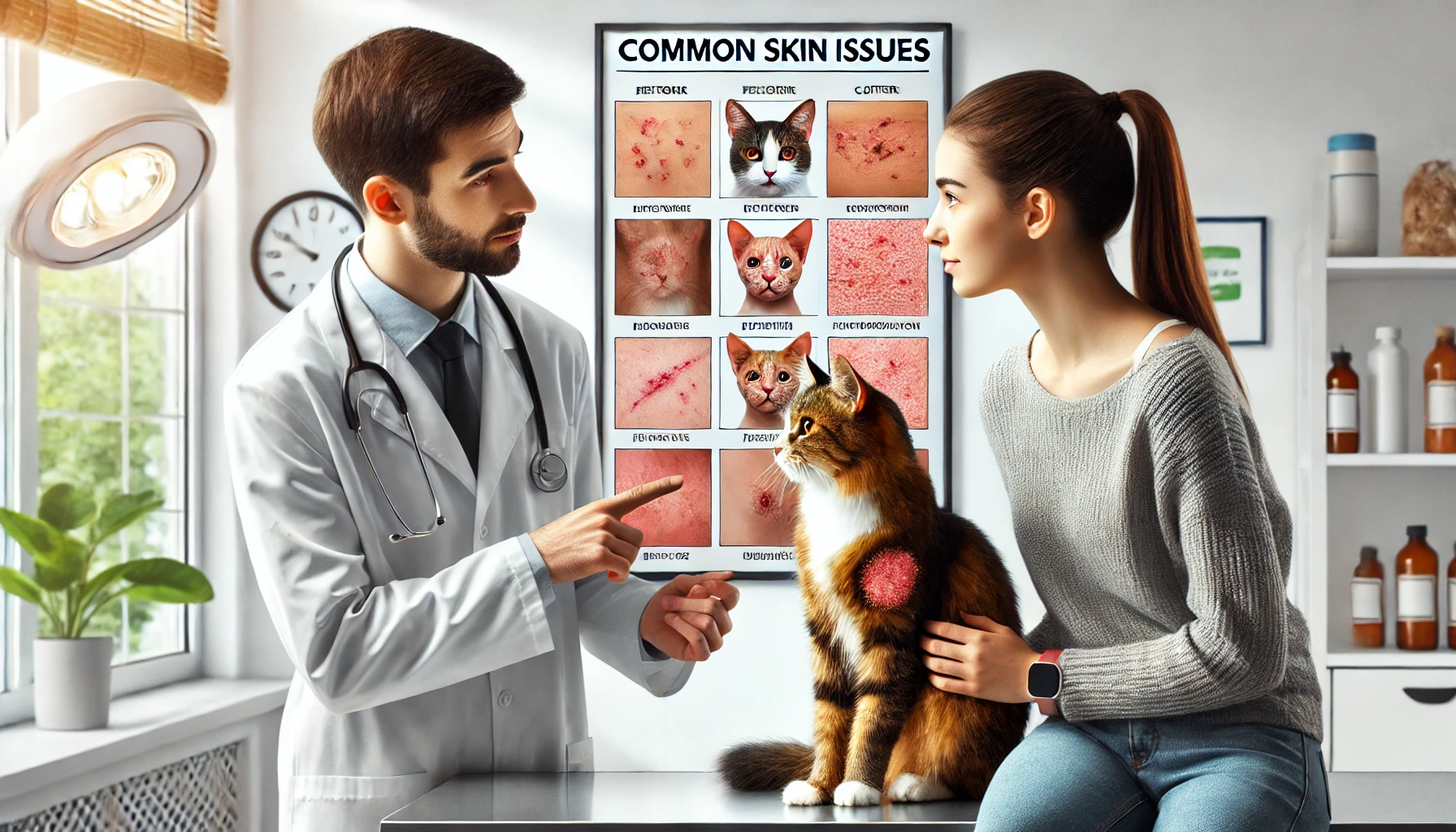
Recognizing and Managing Common Skin Issues
Grooming sessions are the perfect time to observe any signs of irritation, redness, bumps, or hair loss on your cat’s skin.
Common skin problems such as dryness, inflammation, and matted fur can be addressed early to prevent discomfort.
Here are a few essential grooming tips:
- Use the right grooming tools, like slicker brushes or wide-tooth combs, to handle sensitive skin.
- Handle matted fur gently, and use detangling sprays if necessary to avoid skin damage.
- Apply cat-safe shampoos and conditioners to protect their sensitive skin from harsh chemicals.

Understanding the Impact of Parasites on Skin Health
Parasites like fleas, ticks, and mites are common culprits behind skin conditions in cats.
These parasites not only cause itching and irritation but can lead to infections or allergic reactions if left untreated.
Key points to remember include:
- Regularly check your cat’s coat for signs of flea dirt, ticks, or mites.
- Use vet-recommended treatments to control infestations and maintain a parasite prevention regimen.
- Be aware of potential allergic reactions from parasite bites and consult your vet if symptoms persist.
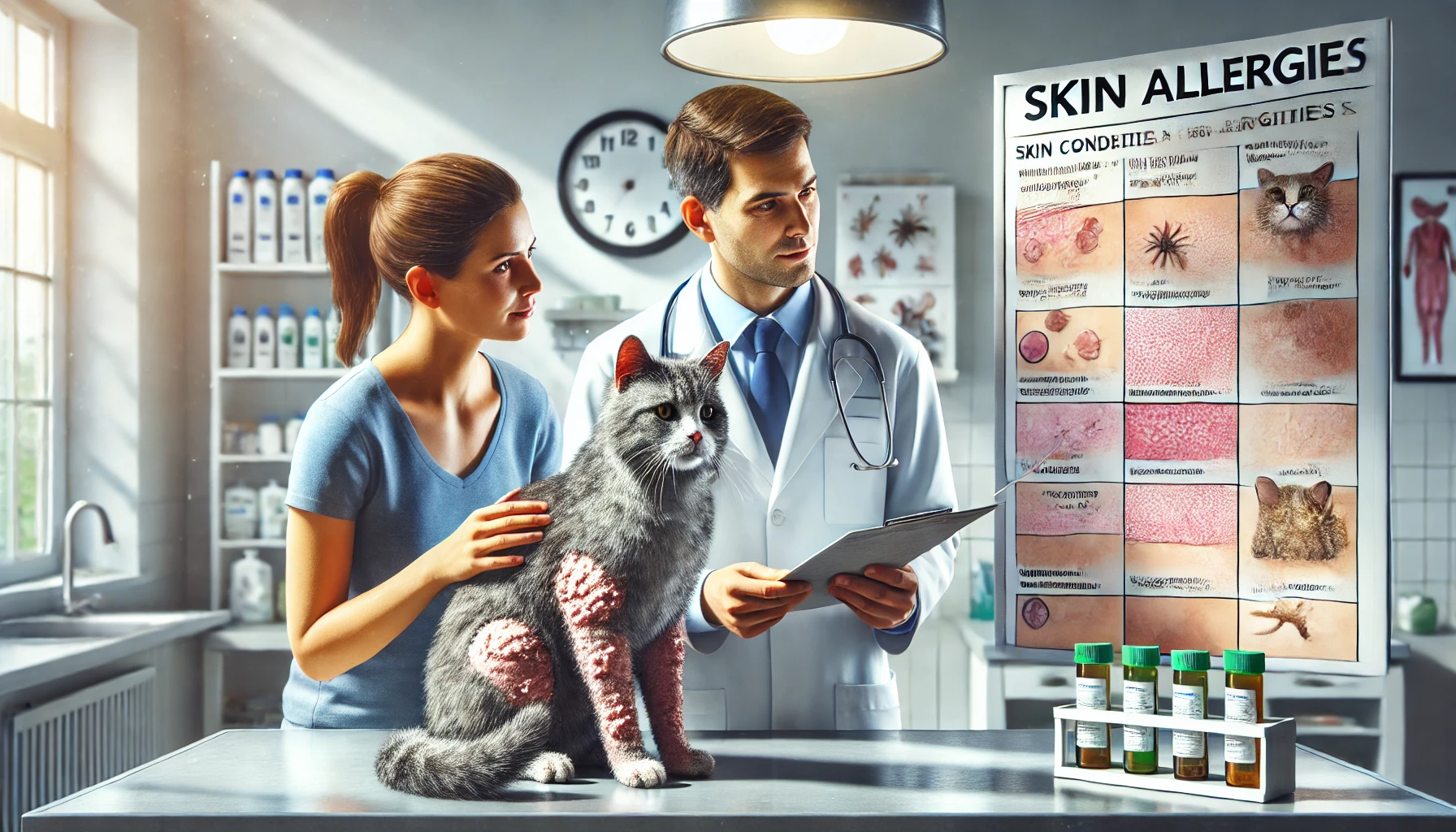
Identifying and Managing Skin Allergies and Sensitivities
Allergies in cats can result from various sources, including food, dust, or pollen.
Recognizing symptoms such as excessive scratching or red patches enables better allergy management.
Some strategies for reducing allergy-related skin issues include:
- Consider a hypoallergenic diet if food allergies are suspected.
- Minimize exposure to environmental allergens by keeping the living space clean and using air purifiers.
- Choose grooming products formulated specifically for cats to avoid irritation.
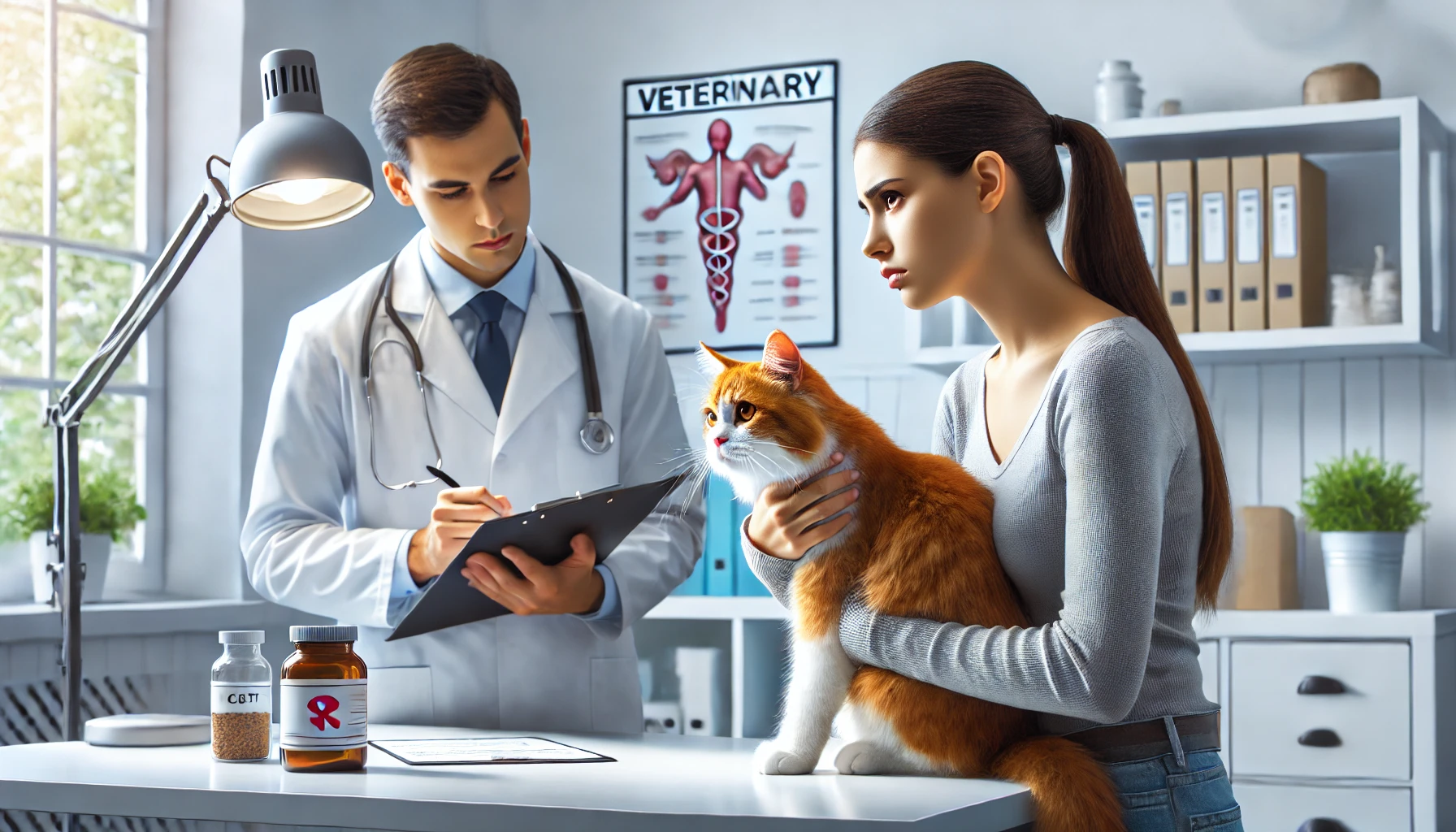
Knowing When to Consult a Veterinarian
While many skin issues can be managed at home, certain symptoms warrant a visit to the vet.
Chronic or worsening skin conditions, as well as signs of systemic illness such as lethargy or appetite loss, indicate the need for professional evaluation.
Routine check-ups and preventive care are also vital for your cat’s skin health.
Key reminders include:
- Schedule annual exams and keep up with vaccinations and parasite control.
- Monitor cats with a history of skin issues closely and seek veterinary advice as needed.
- Consult a vet immediately if your cat shows signs of recurring infections, non-healing sores, or general discomfort.
By following these guidelines and being observant during grooming, you can help maintain your cat’s skin health and contribute to their overall happiness.
Proper grooming, early detection of issues, and timely veterinary care promote a healthier, more comfortable life for your feline companion.
Key Tips for Cat Skin Health
- Use gentle grooming tools like slicker and bristle brushes.
- Regularly check for parasites and seek treatment as needed.
- Monitor for signs of allergies and skin sensitivities, and consult a vet if issues persist.
Regular grooming and awareness of skin health can make a significant difference in your cat’s comfort and well-being.

Grooming and Cat Skin Health: Frequently Asked Questions
Below are answers to some of the most frequently asked questions about managing cat skin health and addressing common skin issues during grooming.
What are the common manifestations of cat skin problems?
Common signs include redness, bumps, hair loss, and excessive scratching.
These symptoms could indicate skin irritations, allergies, or infections that need to be addressed during grooming.
How often should I groom my cat for skin health?
Grooming once or twice a week usually suffices.
Cats with long or dense fur may require more frequent grooming to prevent matting and maintain healthy skin.
What type of brushes work well for cats with sensitive skin?
Slicker brushes, bristle brushes, and wide-tooth combs are best for cats with sensitive skin.
These tools help remove loose fur and tangles without further irritating the skin.
How do I know if my cat has a food allergy?
Food allergies often present as itching, redness, and chronic ear infections.
Consult a vet if you notice these signs to explore an appropriate elimination diet.
My cat has fleas; what should I do?
If you find fleas, use a flea comb and speak to your vet about treatment.
Regular flea prevention can help avoid infestations and protect your cat’s skin.
Are there skin problems in cats related to environmental factors?
Yes, dust, pollen, and mold can cause skin allergies in cats.
Reduce allergens in your cat’s environment, and consider using air purifiers to help manage symptoms.
Are there any natural remedies for minor cat skin irritations?
Oatmeal baths are a common remedy for soothing minor skin irritations.
However, always consult your vet before using natural remedies to rule out any adverse reactions.
How can I safely remove mats from my cat?
Use a detangling spray and a wide-tooth comb to work through mats gently.
Severe mats should be removed by a professional groomer or vet to avoid skin injuries.
When should I take my cat to the vet for skin issues?
If skin issues persist, worsen, or occur with lethargy or appetite loss, consult your vet.
Many chronic problems and infections are best addressed with professional care.

